Understanding and Leading Change in Organizations
VerifiedAdded on 2023/01/12
|22
|7480
|57
AI Summary
This report discusses the importance of organizational change and its impact on organizations. It includes a comparison of organizations, evaluation of drivers of change, and barriers to change. It also explores the application of leadership approaches and models of change management. The case study focuses on Sainsbury's, the second-largest supermarket chain in the UK.
Contribute Materials
Your contribution can guide someone’s learning journey. Share your
documents today.
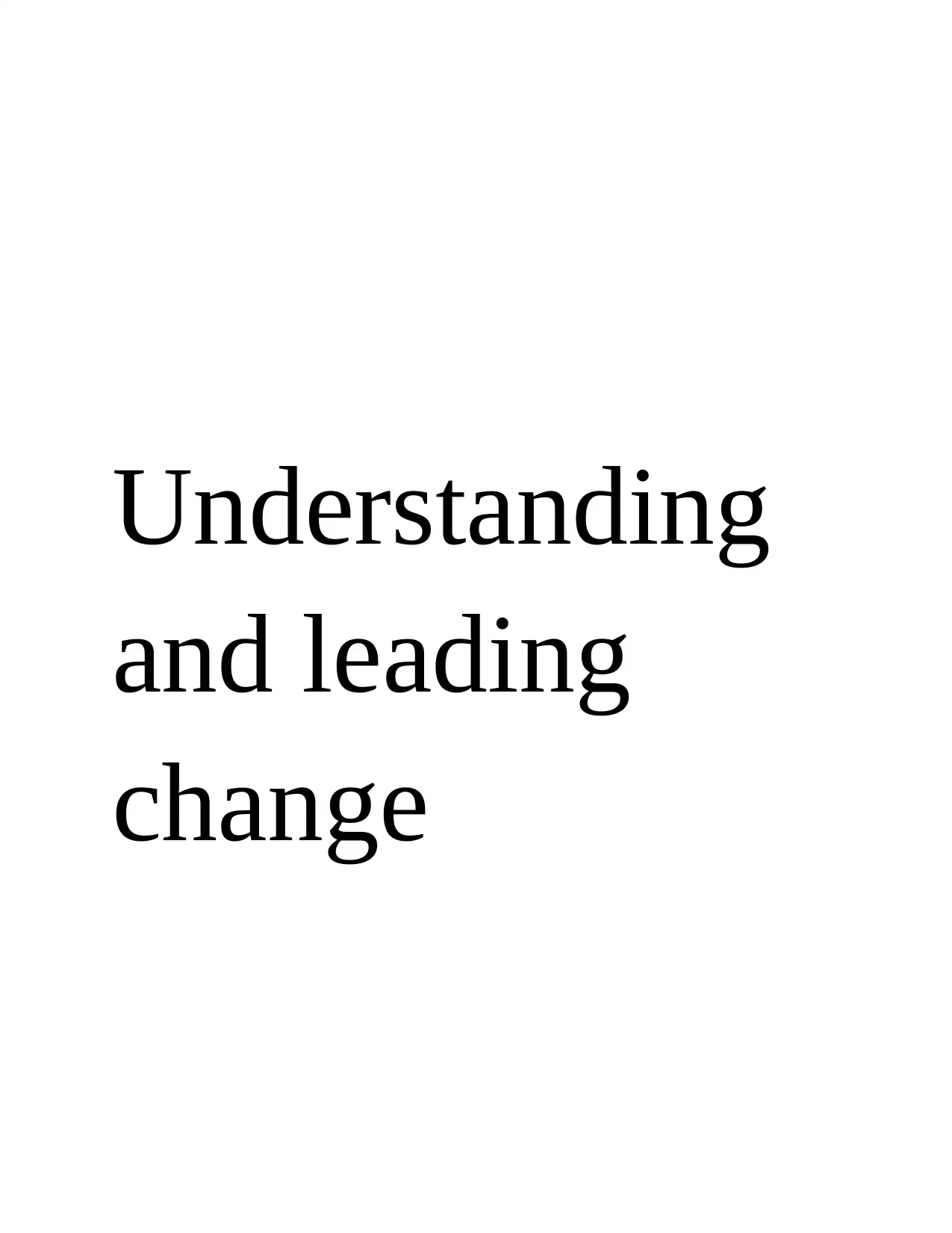
Understanding
and leading
change
and leading
change
Secure Best Marks with AI Grader
Need help grading? Try our AI Grader for instant feedback on your assignments.
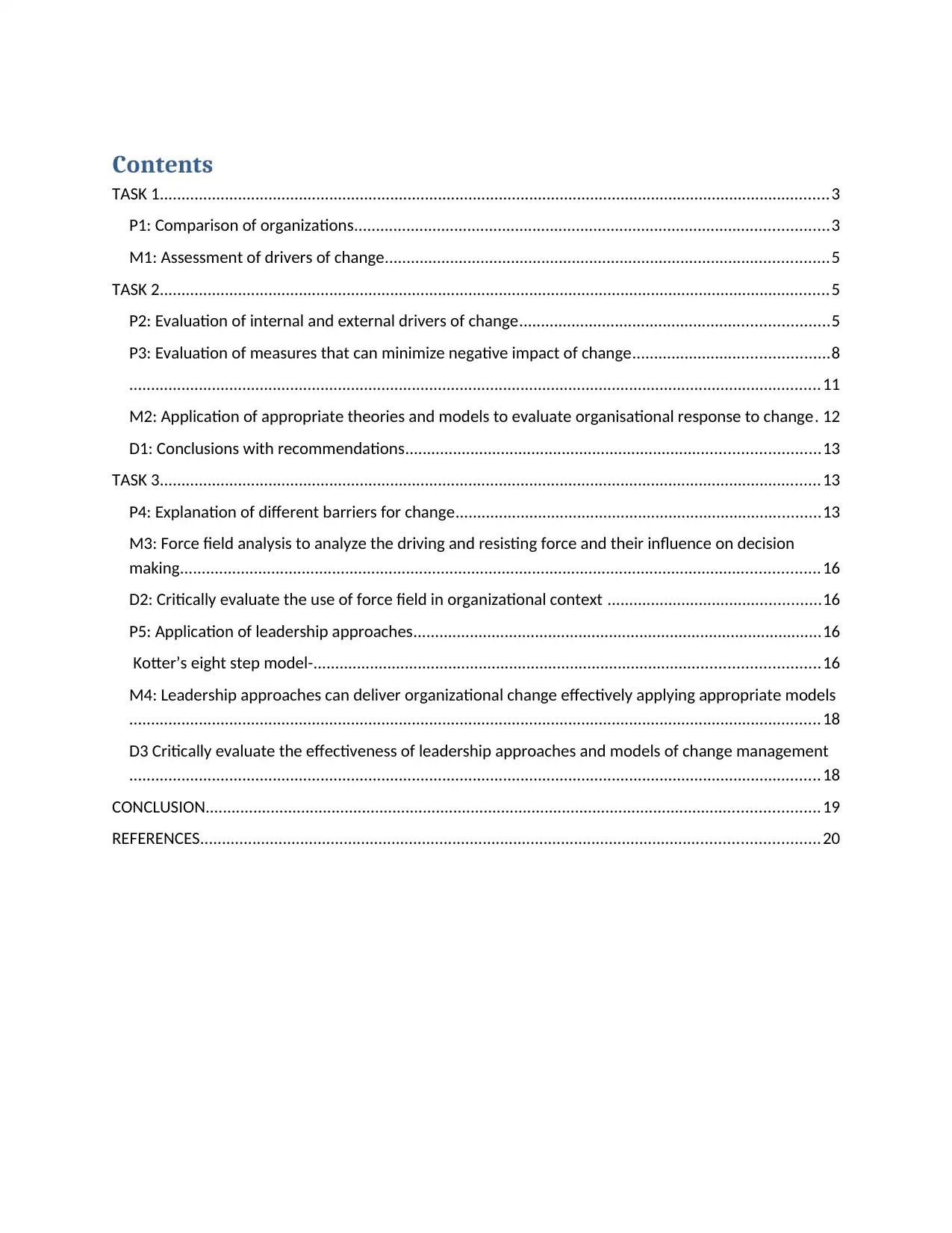
Contents
TASK 1..........................................................................................................................................................3
P1: Comparison of organizations.............................................................................................................3
M1: Assessment of drivers of change......................................................................................................5
TASK 2..........................................................................................................................................................5
P2: Evaluation of internal and external drivers of change.......................................................................5
P3: Evaluation of measures that can minimize negative impact of change.............................................8
...............................................................................................................................................................11
M2: Application of appropriate theories and models to evaluate organisational response to change. 12
D1: Conclusions with recommendations...............................................................................................13
TASK 3........................................................................................................................................................13
P4: Explanation of different barriers for change....................................................................................13
M3: Force field analysis to analyze the driving and resisting force and their influence on decision
making...................................................................................................................................................16
D2: Critically evaluate the use of force field in organizational context .................................................16
P5: Application of leadership approaches..............................................................................................16
Kotter’s eight step model-....................................................................................................................16
M4: Leadership approaches can deliver organizational change effectively applying appropriate models
...............................................................................................................................................................18
D3 Critically evaluate the effectiveness of leadership approaches and models of change management
...............................................................................................................................................................18
CONCLUSION.............................................................................................................................................19
REFERENCES..............................................................................................................................................20
TASK 1..........................................................................................................................................................3
P1: Comparison of organizations.............................................................................................................3
M1: Assessment of drivers of change......................................................................................................5
TASK 2..........................................................................................................................................................5
P2: Evaluation of internal and external drivers of change.......................................................................5
P3: Evaluation of measures that can minimize negative impact of change.............................................8
...............................................................................................................................................................11
M2: Application of appropriate theories and models to evaluate organisational response to change. 12
D1: Conclusions with recommendations...............................................................................................13
TASK 3........................................................................................................................................................13
P4: Explanation of different barriers for change....................................................................................13
M3: Force field analysis to analyze the driving and resisting force and their influence on decision
making...................................................................................................................................................16
D2: Critically evaluate the use of force field in organizational context .................................................16
P5: Application of leadership approaches..............................................................................................16
Kotter’s eight step model-....................................................................................................................16
M4: Leadership approaches can deliver organizational change effectively applying appropriate models
...............................................................................................................................................................18
D3 Critically evaluate the effectiveness of leadership approaches and models of change management
...............................................................................................................................................................18
CONCLUSION.............................................................................................................................................19
REFERENCES..............................................................................................................................................20
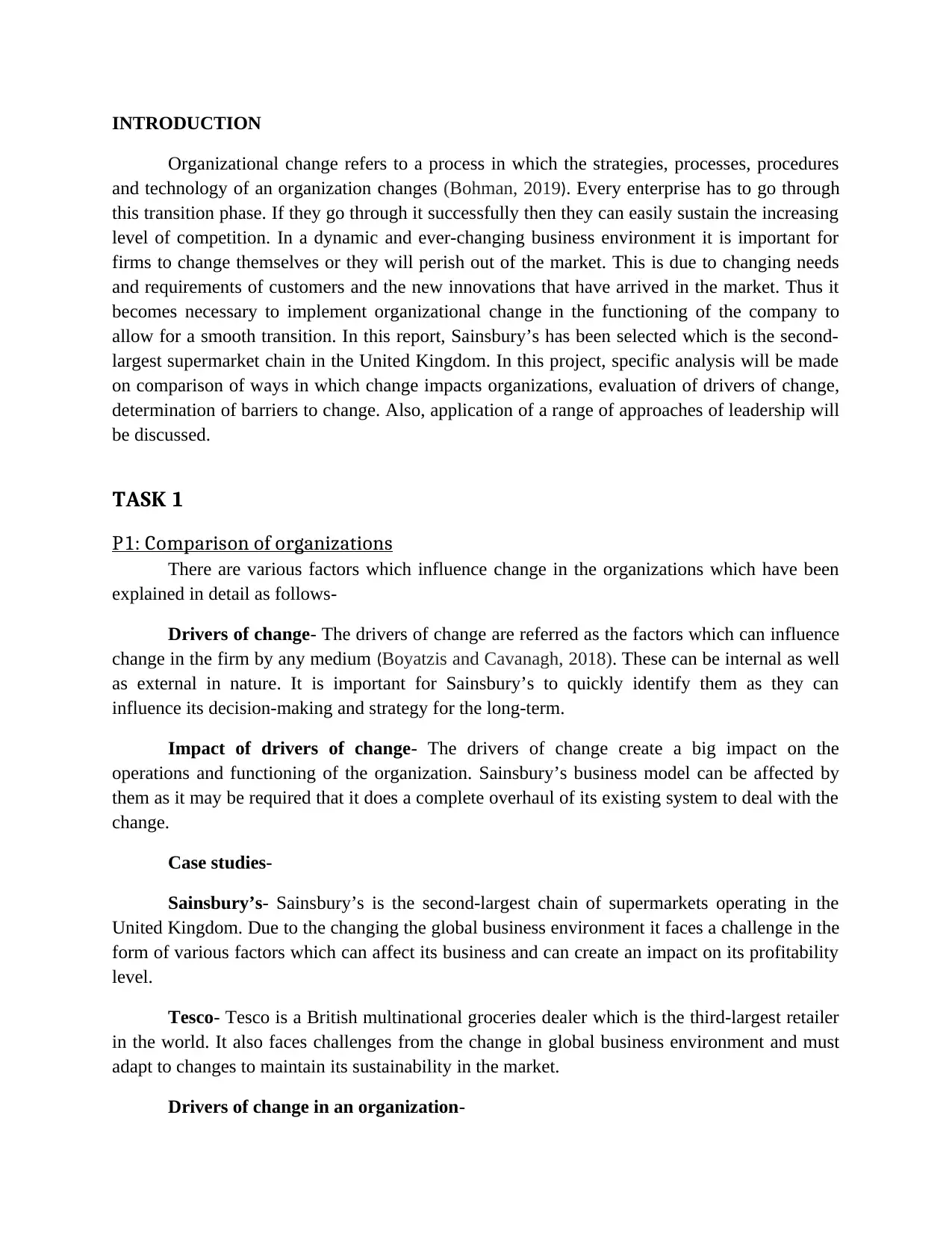
INTRODUCTION
Organizational change refers to a process in which the strategies, processes, procedures
and technology of an organization changes (Bohman, 2019). Every enterprise has to go through
this transition phase. If they go through it successfully then they can easily sustain the increasing
level of competition. In a dynamic and ever-changing business environment it is important for
firms to change themselves or they will perish out of the market. This is due to changing needs
and requirements of customers and the new innovations that have arrived in the market. Thus it
becomes necessary to implement organizational change in the functioning of the company to
allow for a smooth transition. In this report, Sainsbury’s has been selected which is the second-
largest supermarket chain in the United Kingdom. In this project, specific analysis will be made
on comparison of ways in which change impacts organizations, evaluation of drivers of change,
determination of barriers to change. Also, application of a range of approaches of leadership will
be discussed.
TASK 1
P1: Comparison of organizations
There are various factors which influence change in the organizations which have been
explained in detail as follows-
Drivers of change- The drivers of change are referred as the factors which can influence
change in the firm by any medium (Boyatzis and Cavanagh, 2018). These can be internal as well
as external in nature. It is important for Sainsbury’s to quickly identify them as they can
influence its decision-making and strategy for the long-term.
Impact of drivers of change- The drivers of change create a big impact on the
operations and functioning of the organization. Sainsbury’s business model can be affected by
them as it may be required that it does a complete overhaul of its existing system to deal with the
change.
Case studies-
Sainsbury’s- Sainsbury’s is the second-largest chain of supermarkets operating in the
United Kingdom. Due to the changing the global business environment it faces a challenge in the
form of various factors which can affect its business and can create an impact on its profitability
level.
Tesco- Tesco is a British multinational groceries dealer which is the third-largest retailer
in the world. It also faces challenges from the change in global business environment and must
adapt to changes to maintain its sustainability in the market.
Drivers of change in an organization-
Organizational change refers to a process in which the strategies, processes, procedures
and technology of an organization changes (Bohman, 2019). Every enterprise has to go through
this transition phase. If they go through it successfully then they can easily sustain the increasing
level of competition. In a dynamic and ever-changing business environment it is important for
firms to change themselves or they will perish out of the market. This is due to changing needs
and requirements of customers and the new innovations that have arrived in the market. Thus it
becomes necessary to implement organizational change in the functioning of the company to
allow for a smooth transition. In this report, Sainsbury’s has been selected which is the second-
largest supermarket chain in the United Kingdom. In this project, specific analysis will be made
on comparison of ways in which change impacts organizations, evaluation of drivers of change,
determination of barriers to change. Also, application of a range of approaches of leadership will
be discussed.
TASK 1
P1: Comparison of organizations
There are various factors which influence change in the organizations which have been
explained in detail as follows-
Drivers of change- The drivers of change are referred as the factors which can influence
change in the firm by any medium (Boyatzis and Cavanagh, 2018). These can be internal as well
as external in nature. It is important for Sainsbury’s to quickly identify them as they can
influence its decision-making and strategy for the long-term.
Impact of drivers of change- The drivers of change create a big impact on the
operations and functioning of the organization. Sainsbury’s business model can be affected by
them as it may be required that it does a complete overhaul of its existing system to deal with the
change.
Case studies-
Sainsbury’s- Sainsbury’s is the second-largest chain of supermarkets operating in the
United Kingdom. Due to the changing the global business environment it faces a challenge in the
form of various factors which can affect its business and can create an impact on its profitability
level.
Tesco- Tesco is a British multinational groceries dealer which is the third-largest retailer
in the world. It also faces challenges from the change in global business environment and must
adapt to changes to maintain its sustainability in the market.
Drivers of change in an organization-
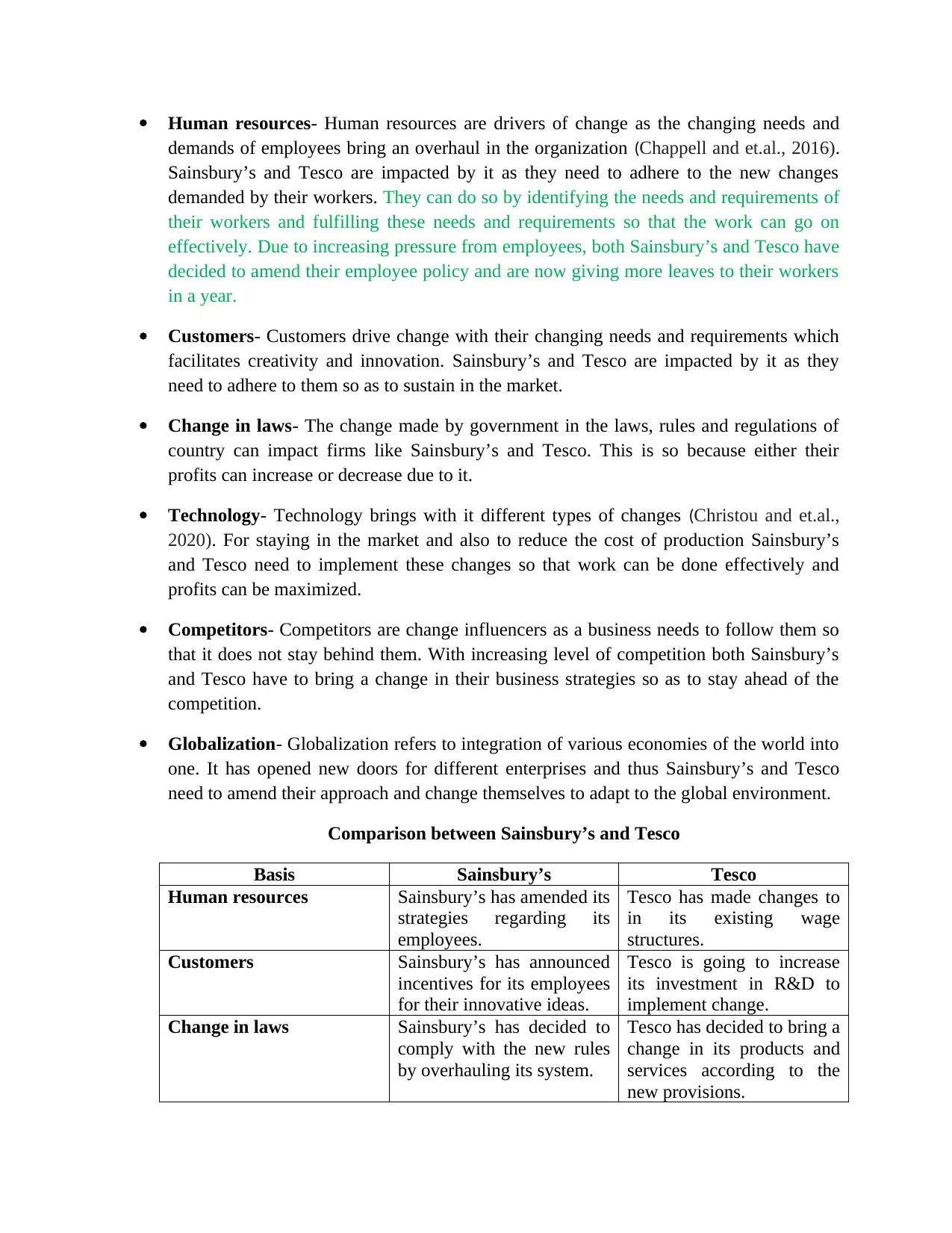
Human resources- Human resources are drivers of change as the changing needs and
demands of employees bring an overhaul in the organization (Chappell and et.al., 2016).
Sainsbury’s and Tesco are impacted by it as they need to adhere to the new changes
demanded by their workers. They can do so by identifying the needs and requirements of
their workers and fulfilling these needs and requirements so that the work can go on
effectively. Due to increasing pressure from employees, both Sainsbury’s and Tesco have
decided to amend their employee policy and are now giving more leaves to their workers
in a year.
Customers- Customers drive change with their changing needs and requirements which
facilitates creativity and innovation. Sainsbury’s and Tesco are impacted by it as they
need to adhere to them so as to sustain in the market.
Change in laws- The change made by government in the laws, rules and regulations of
country can impact firms like Sainsbury’s and Tesco. This is so because either their
profits can increase or decrease due to it.
Technology- Technology brings with it different types of changes (Christou and et.al.,
2020). For staying in the market and also to reduce the cost of production Sainsbury’s
and Tesco need to implement these changes so that work can be done effectively and
profits can be maximized.
Competitors- Competitors are change influencers as a business needs to follow them so
that it does not stay behind them. With increasing level of competition both Sainsbury’s
and Tesco have to bring a change in their business strategies so as to stay ahead of the
competition.
Globalization- Globalization refers to integration of various economies of the world into
one. It has opened new doors for different enterprises and thus Sainsbury’s and Tesco
need to amend their approach and change themselves to adapt to the global environment.
Comparison between Sainsbury’s and Tesco
Basis Sainsbury’s Tesco
Human resources Sainsbury’s has amended its
strategies regarding its
employees.
Tesco has made changes to
in its existing wage
structures.
Customers Sainsbury’s has announced
incentives for its employees
for their innovative ideas.
Tesco is going to increase
its investment in R&D to
implement change.
Change in laws Sainsbury’s has decided to
comply with the new rules
by overhauling its system.
Tesco has decided to bring a
change in its products and
services according to the
new provisions.
demands of employees bring an overhaul in the organization (Chappell and et.al., 2016).
Sainsbury’s and Tesco are impacted by it as they need to adhere to the new changes
demanded by their workers. They can do so by identifying the needs and requirements of
their workers and fulfilling these needs and requirements so that the work can go on
effectively. Due to increasing pressure from employees, both Sainsbury’s and Tesco have
decided to amend their employee policy and are now giving more leaves to their workers
in a year.
Customers- Customers drive change with their changing needs and requirements which
facilitates creativity and innovation. Sainsbury’s and Tesco are impacted by it as they
need to adhere to them so as to sustain in the market.
Change in laws- The change made by government in the laws, rules and regulations of
country can impact firms like Sainsbury’s and Tesco. This is so because either their
profits can increase or decrease due to it.
Technology- Technology brings with it different types of changes (Christou and et.al.,
2020). For staying in the market and also to reduce the cost of production Sainsbury’s
and Tesco need to implement these changes so that work can be done effectively and
profits can be maximized.
Competitors- Competitors are change influencers as a business needs to follow them so
that it does not stay behind them. With increasing level of competition both Sainsbury’s
and Tesco have to bring a change in their business strategies so as to stay ahead of the
competition.
Globalization- Globalization refers to integration of various economies of the world into
one. It has opened new doors for different enterprises and thus Sainsbury’s and Tesco
need to amend their approach and change themselves to adapt to the global environment.
Comparison between Sainsbury’s and Tesco
Basis Sainsbury’s Tesco
Human resources Sainsbury’s has amended its
strategies regarding its
employees.
Tesco has made changes to
in its existing wage
structures.
Customers Sainsbury’s has announced
incentives for its employees
for their innovative ideas.
Tesco is going to increase
its investment in R&D to
implement change.
Change in laws Sainsbury’s has decided to
comply with the new rules
by overhauling its system.
Tesco has decided to bring a
change in its products and
services according to the
new provisions.
Secure Best Marks with AI Grader
Need help grading? Try our AI Grader for instant feedback on your assignments.
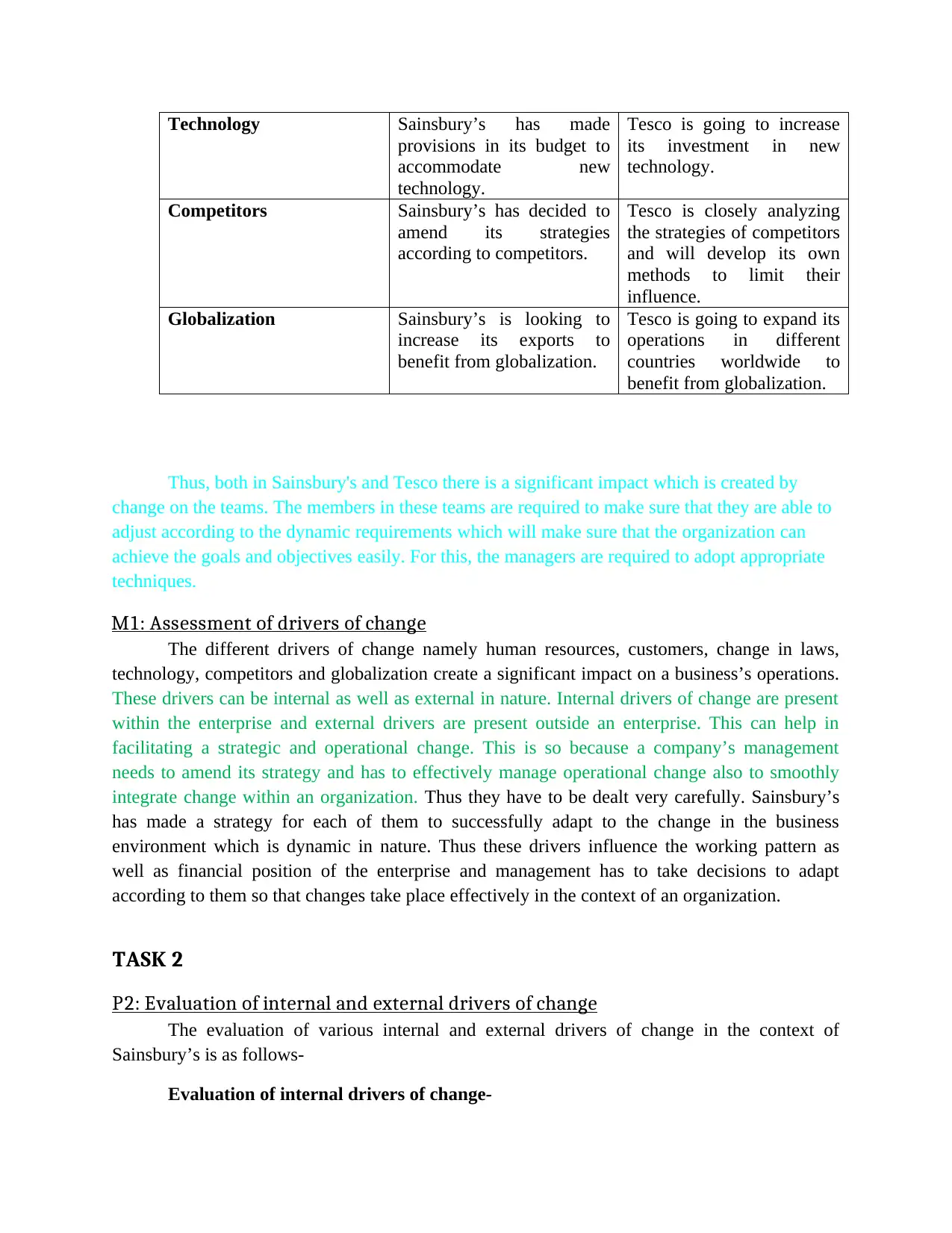
Technology Sainsbury’s has made
provisions in its budget to
accommodate new
technology.
Tesco is going to increase
its investment in new
technology.
Competitors Sainsbury’s has decided to
amend its strategies
according to competitors.
Tesco is closely analyzing
the strategies of competitors
and will develop its own
methods to limit their
influence.
Globalization Sainsbury’s is looking to
increase its exports to
benefit from globalization.
Tesco is going to expand its
operations in different
countries worldwide to
benefit from globalization.
Thus, both in Sainsbury's and Tesco there is a significant impact which is created by
change on the teams. The members in these teams are required to make sure that they are able to
adjust according to the dynamic requirements which will make sure that the organization can
achieve the goals and objectives easily. For this, the managers are required to adopt appropriate
techniques.
M1: Assessment of drivers of change
The different drivers of change namely human resources, customers, change in laws,
technology, competitors and globalization create a significant impact on a business’s operations.
These drivers can be internal as well as external in nature. Internal drivers of change are present
within the enterprise and external drivers are present outside an enterprise. This can help in
facilitating a strategic and operational change. This is so because a company’s management
needs to amend its strategy and has to effectively manage operational change also to smoothly
integrate change within an organization. Thus they have to be dealt very carefully. Sainsbury’s
has made a strategy for each of them to successfully adapt to the change in the business
environment which is dynamic in nature. Thus these drivers influence the working pattern as
well as financial position of the enterprise and management has to take decisions to adapt
according to them so that changes take place effectively in the context of an organization.
TASK 2
P2: Evaluation of internal and external drivers of change
The evaluation of various internal and external drivers of change in the context of
Sainsbury’s is as follows-
Evaluation of internal drivers of change-
provisions in its budget to
accommodate new
technology.
Tesco is going to increase
its investment in new
technology.
Competitors Sainsbury’s has decided to
amend its strategies
according to competitors.
Tesco is closely analyzing
the strategies of competitors
and will develop its own
methods to limit their
influence.
Globalization Sainsbury’s is looking to
increase its exports to
benefit from globalization.
Tesco is going to expand its
operations in different
countries worldwide to
benefit from globalization.
Thus, both in Sainsbury's and Tesco there is a significant impact which is created by
change on the teams. The members in these teams are required to make sure that they are able to
adjust according to the dynamic requirements which will make sure that the organization can
achieve the goals and objectives easily. For this, the managers are required to adopt appropriate
techniques.
M1: Assessment of drivers of change
The different drivers of change namely human resources, customers, change in laws,
technology, competitors and globalization create a significant impact on a business’s operations.
These drivers can be internal as well as external in nature. Internal drivers of change are present
within the enterprise and external drivers are present outside an enterprise. This can help in
facilitating a strategic and operational change. This is so because a company’s management
needs to amend its strategy and has to effectively manage operational change also to smoothly
integrate change within an organization. Thus they have to be dealt very carefully. Sainsbury’s
has made a strategy for each of them to successfully adapt to the change in the business
environment which is dynamic in nature. Thus these drivers influence the working pattern as
well as financial position of the enterprise and management has to take decisions to adapt
according to them so that changes take place effectively in the context of an organization.
TASK 2
P2: Evaluation of internal and external drivers of change
The evaluation of various internal and external drivers of change in the context of
Sainsbury’s is as follows-
Evaluation of internal drivers of change-
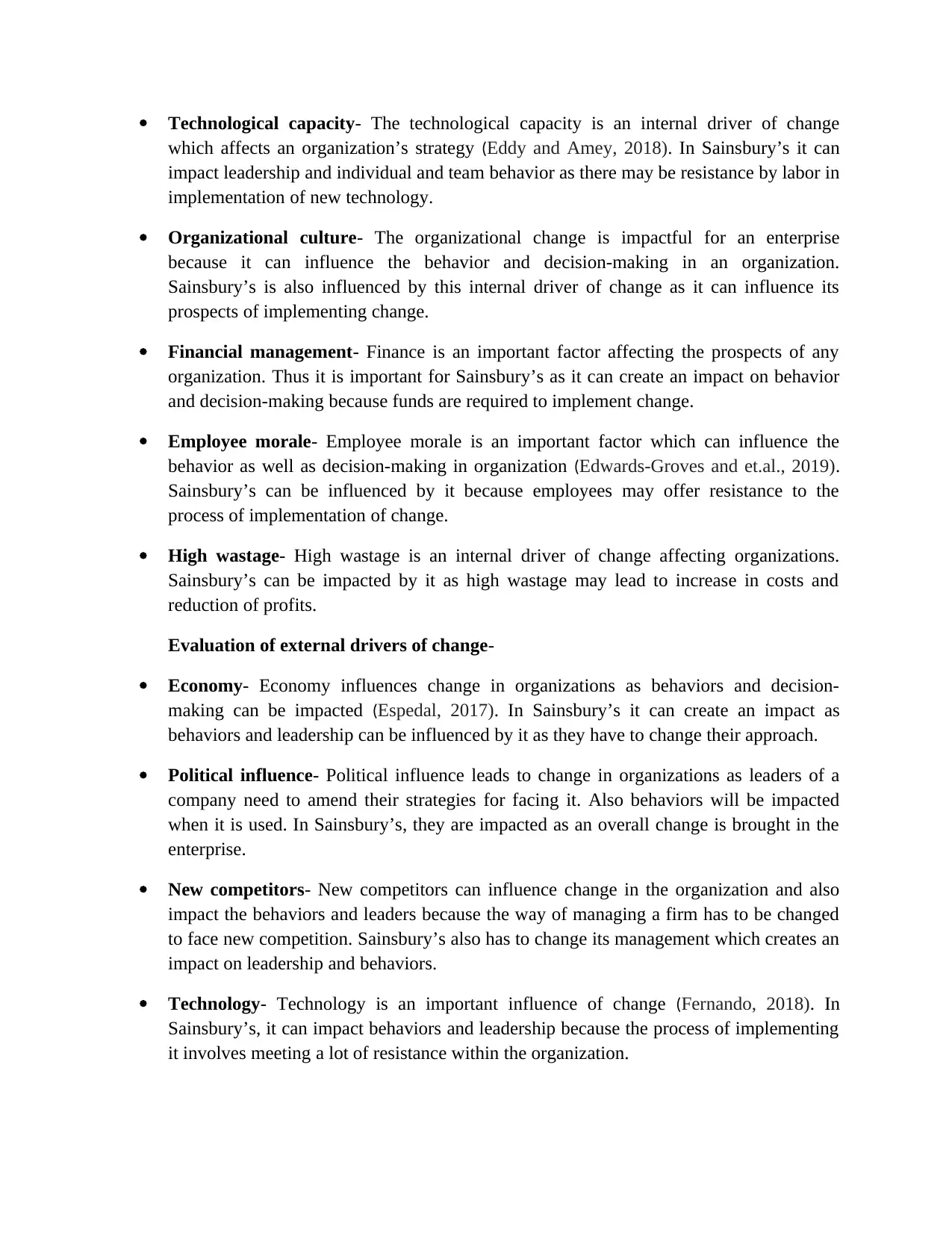
Technological capacity- The technological capacity is an internal driver of change
which affects an organization’s strategy (Eddy and Amey, 2018). In Sainsbury’s it can
impact leadership and individual and team behavior as there may be resistance by labor in
implementation of new technology.
Organizational culture- The organizational change is impactful for an enterprise
because it can influence the behavior and decision-making in an organization.
Sainsbury’s is also influenced by this internal driver of change as it can influence its
prospects of implementing change.
Financial management- Finance is an important factor affecting the prospects of any
organization. Thus it is important for Sainsbury’s as it can create an impact on behavior
and decision-making because funds are required to implement change.
Employee morale- Employee morale is an important factor which can influence the
behavior as well as decision-making in organization (Edwards-Groves and et.al., 2019).
Sainsbury’s can be influenced by it because employees may offer resistance to the
process of implementation of change.
High wastage- High wastage is an internal driver of change affecting organizations.
Sainsbury’s can be impacted by it as high wastage may lead to increase in costs and
reduction of profits.
Evaluation of external drivers of change-
Economy- Economy influences change in organizations as behaviors and decision-
making can be impacted (Espedal, 2017). In Sainsbury’s it can create an impact as
behaviors and leadership can be influenced by it as they have to change their approach.
Political influence- Political influence leads to change in organizations as leaders of a
company need to amend their strategies for facing it. Also behaviors will be impacted
when it is used. In Sainsbury’s, they are impacted as an overall change is brought in the
enterprise.
New competitors- New competitors can influence change in the organization and also
impact the behaviors and leaders because the way of managing a firm has to be changed
to face new competition. Sainsbury’s also has to change its management which creates an
impact on leadership and behaviors.
Technology- Technology is an important influence of change (Fernando, 2018). In
Sainsbury’s, it can impact behaviors and leadership because the process of implementing
it involves meeting a lot of resistance within the organization.
which affects an organization’s strategy (Eddy and Amey, 2018). In Sainsbury’s it can
impact leadership and individual and team behavior as there may be resistance by labor in
implementation of new technology.
Organizational culture- The organizational change is impactful for an enterprise
because it can influence the behavior and decision-making in an organization.
Sainsbury’s is also influenced by this internal driver of change as it can influence its
prospects of implementing change.
Financial management- Finance is an important factor affecting the prospects of any
organization. Thus it is important for Sainsbury’s as it can create an impact on behavior
and decision-making because funds are required to implement change.
Employee morale- Employee morale is an important factor which can influence the
behavior as well as decision-making in organization (Edwards-Groves and et.al., 2019).
Sainsbury’s can be influenced by it because employees may offer resistance to the
process of implementation of change.
High wastage- High wastage is an internal driver of change affecting organizations.
Sainsbury’s can be impacted by it as high wastage may lead to increase in costs and
reduction of profits.
Evaluation of external drivers of change-
Economy- Economy influences change in organizations as behaviors and decision-
making can be impacted (Espedal, 2017). In Sainsbury’s it can create an impact as
behaviors and leadership can be influenced by it as they have to change their approach.
Political influence- Political influence leads to change in organizations as leaders of a
company need to amend their strategies for facing it. Also behaviors will be impacted
when it is used. In Sainsbury’s, they are impacted as an overall change is brought in the
enterprise.
New competitors- New competitors can influence change in the organization and also
impact the behaviors and leaders because the way of managing a firm has to be changed
to face new competition. Sainsbury’s also has to change its management which creates an
impact on leadership and behaviors.
Technology- Technology is an important influence of change (Fernando, 2018). In
Sainsbury’s, it can impact behaviors and leadership because the process of implementing
it involves meeting a lot of resistance within the organization.

Customer satisfaction- Customer satisfaction influences change in the organization. In
Sainsbury’s, behaviors and leadership can be impacted by it because the processes have
to be changed in the organization to enhance customer satisfaction.
SWOT analysis of Sainsbury’s
Strengths Weaknesses
Large customer base is strength of
Sainsbury’s because of its brand
image.
Sainsbury’s provides quality
product and services to its
customers which is its strength as it
creates goodwill in the market.
Sainsbury’s faces problems related
to inefficiency of its staff as
sometimes there have been
complaints regarding bad behavior
with customers.
Sainsbury’s digital marketing
strategies are behind that of its
competitors.
Opportunities Threats
Expansion in new international
markets offers Sainsbury’s an
opportunity to maximize its profits.
Using new technology, Sainsbury’s
can reduce its costs and can also get
ahead of its competitors.
The new taxation policy affects
Sainsbury’s as it can significantly
reduce its profits.
Increasing level of competition
threatens to impact the business of
Sainsbury’s as its customer base can
shift to competitors.
PESTLE analysis of Sainsbury’s-
Political factors- These factors are government policy, political stability etc. Sainsbury’s
is influenced by them as they can affect its operations and functioning. They influence
the drivers of change as the firm can be influenced by a change in political factors which
can impact its operations either positively or negatively. For example- If there is a change
in government policy and it favors Sainsbury’s then its business will see a positive
growth.
Economic factors- These factors are economic growth, exchange rates, interest rates etc.
Sainsbury’s is influenced by them as they can affect its level of profits (Glass and Cook,
2016). They can influence the drivers of change as a change in economy will directly
impact the profitability level of the firms. For example- Change has been brought to
businesses due to the onset of Brexit which has changed various things for them.
Social factors- These are population, age distribution, social and cultural barriers etc.
These factors affect Sainsbury’s as its operations and functioning is impacted by them.
These factors can influence drivers of change as change in society directly inflicts change
Sainsbury’s, behaviors and leadership can be impacted by it because the processes have
to be changed in the organization to enhance customer satisfaction.
SWOT analysis of Sainsbury’s
Strengths Weaknesses
Large customer base is strength of
Sainsbury’s because of its brand
image.
Sainsbury’s provides quality
product and services to its
customers which is its strength as it
creates goodwill in the market.
Sainsbury’s faces problems related
to inefficiency of its staff as
sometimes there have been
complaints regarding bad behavior
with customers.
Sainsbury’s digital marketing
strategies are behind that of its
competitors.
Opportunities Threats
Expansion in new international
markets offers Sainsbury’s an
opportunity to maximize its profits.
Using new technology, Sainsbury’s
can reduce its costs and can also get
ahead of its competitors.
The new taxation policy affects
Sainsbury’s as it can significantly
reduce its profits.
Increasing level of competition
threatens to impact the business of
Sainsbury’s as its customer base can
shift to competitors.
PESTLE analysis of Sainsbury’s-
Political factors- These factors are government policy, political stability etc. Sainsbury’s
is influenced by them as they can affect its operations and functioning. They influence
the drivers of change as the firm can be influenced by a change in political factors which
can impact its operations either positively or negatively. For example- If there is a change
in government policy and it favors Sainsbury’s then its business will see a positive
growth.
Economic factors- These factors are economic growth, exchange rates, interest rates etc.
Sainsbury’s is influenced by them as they can affect its level of profits (Glass and Cook,
2016). They can influence the drivers of change as a change in economy will directly
impact the profitability level of the firms. For example- Change has been brought to
businesses due to the onset of Brexit which has changed various things for them.
Social factors- These are population, age distribution, social and cultural barriers etc.
These factors affect Sainsbury’s as its operations and functioning is impacted by them.
These factors can influence drivers of change as change in society directly inflicts change
Paraphrase This Document
Need a fresh take? Get an instant paraphrase of this document with our AI Paraphraser
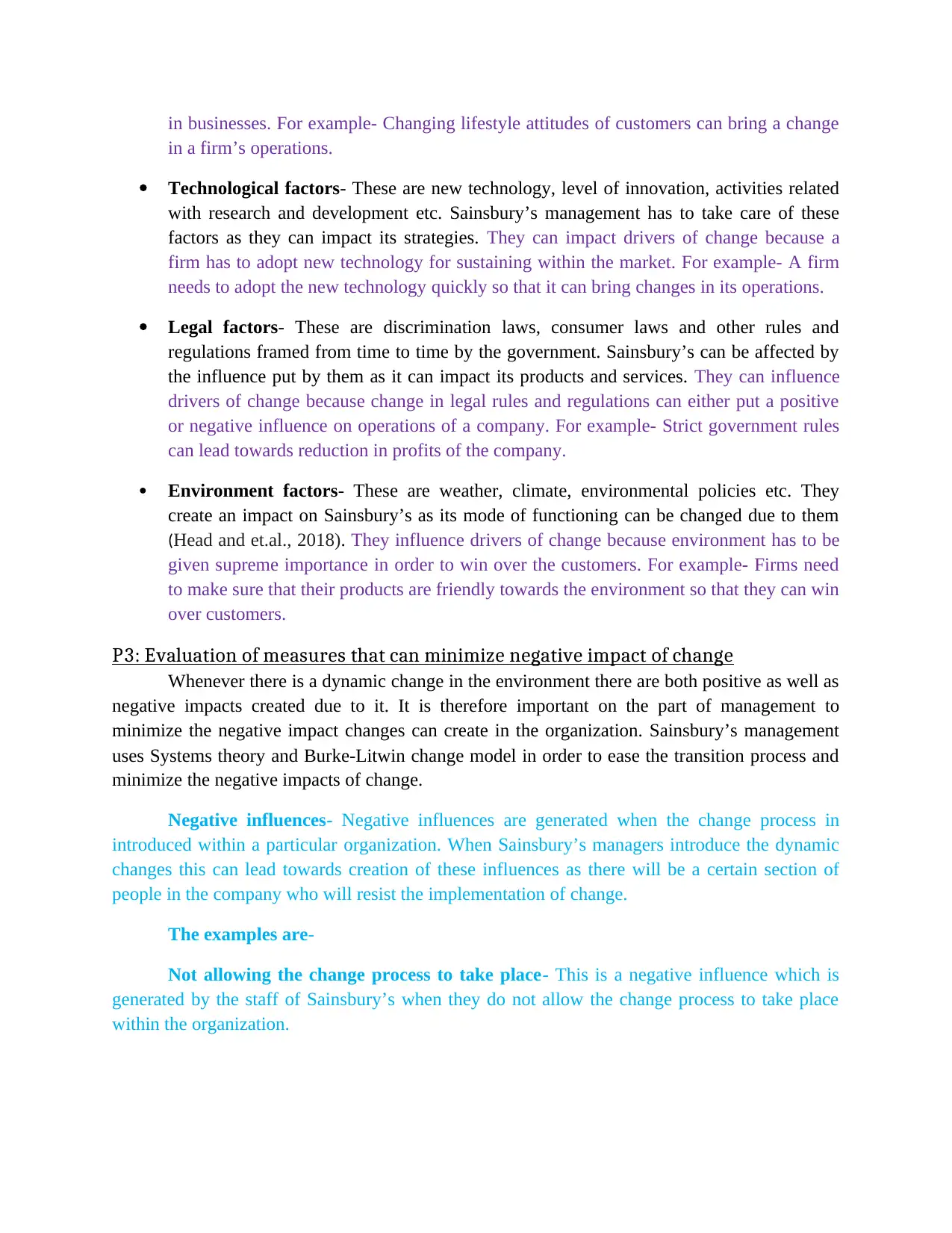
in businesses. For example- Changing lifestyle attitudes of customers can bring a change
in a firm’s operations.
Technological factors- These are new technology, level of innovation, activities related
with research and development etc. Sainsbury’s management has to take care of these
factors as they can impact its strategies. They can impact drivers of change because a
firm has to adopt new technology for sustaining within the market. For example- A firm
needs to adopt the new technology quickly so that it can bring changes in its operations.
Legal factors- These are discrimination laws, consumer laws and other rules and
regulations framed from time to time by the government. Sainsbury’s can be affected by
the influence put by them as it can impact its products and services. They can influence
drivers of change because change in legal rules and regulations can either put a positive
or negative influence on operations of a company. For example- Strict government rules
can lead towards reduction in profits of the company.
Environment factors- These are weather, climate, environmental policies etc. They
create an impact on Sainsbury’s as its mode of functioning can be changed due to them
(Head and et.al., 2018). They influence drivers of change because environment has to be
given supreme importance in order to win over the customers. For example- Firms need
to make sure that their products are friendly towards the environment so that they can win
over customers.
P3: Evaluation of measures that can minimize negative impact of change
Whenever there is a dynamic change in the environment there are both positive as well as
negative impacts created due to it. It is therefore important on the part of management to
minimize the negative impact changes can create in the organization. Sainsbury’s management
uses Systems theory and Burke-Litwin change model in order to ease the transition process and
minimize the negative impacts of change.
Negative influences- Negative influences are generated when the change process in
introduced within a particular organization. When Sainsbury’s managers introduce the dynamic
changes this can lead towards creation of these influences as there will be a certain section of
people in the company who will resist the implementation of change.
The examples are-
Not allowing the change process to take place- This is a negative influence which is
generated by the staff of Sainsbury’s when they do not allow the change process to take place
within the organization.
in a firm’s operations.
Technological factors- These are new technology, level of innovation, activities related
with research and development etc. Sainsbury’s management has to take care of these
factors as they can impact its strategies. They can impact drivers of change because a
firm has to adopt new technology for sustaining within the market. For example- A firm
needs to adopt the new technology quickly so that it can bring changes in its operations.
Legal factors- These are discrimination laws, consumer laws and other rules and
regulations framed from time to time by the government. Sainsbury’s can be affected by
the influence put by them as it can impact its products and services. They can influence
drivers of change because change in legal rules and regulations can either put a positive
or negative influence on operations of a company. For example- Strict government rules
can lead towards reduction in profits of the company.
Environment factors- These are weather, climate, environmental policies etc. They
create an impact on Sainsbury’s as its mode of functioning can be changed due to them
(Head and et.al., 2018). They influence drivers of change because environment has to be
given supreme importance in order to win over the customers. For example- Firms need
to make sure that their products are friendly towards the environment so that they can win
over customers.
P3: Evaluation of measures that can minimize negative impact of change
Whenever there is a dynamic change in the environment there are both positive as well as
negative impacts created due to it. It is therefore important on the part of management to
minimize the negative impact changes can create in the organization. Sainsbury’s management
uses Systems theory and Burke-Litwin change model in order to ease the transition process and
minimize the negative impacts of change.
Negative influences- Negative influences are generated when the change process in
introduced within a particular organization. When Sainsbury’s managers introduce the dynamic
changes this can lead towards creation of these influences as there will be a certain section of
people in the company who will resist the implementation of change.
The examples are-
Not allowing the change process to take place- This is a negative influence which is
generated by the staff of Sainsbury’s when they do not allow the change process to take place
within the organization.
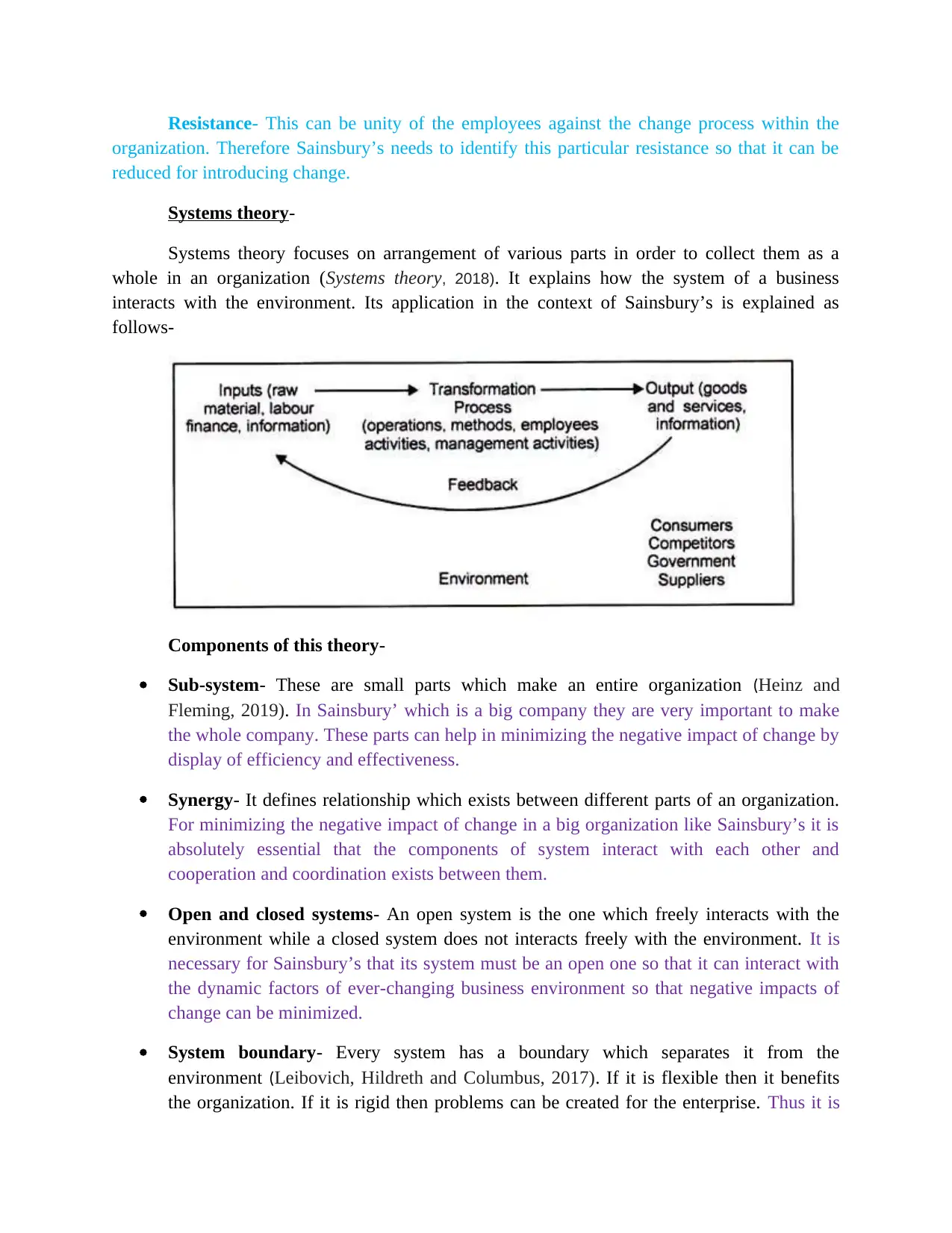
Resistance- This can be unity of the employees against the change process within the
organization. Therefore Sainsbury’s needs to identify this particular resistance so that it can be
reduced for introducing change.
Systems theory-
Systems theory focuses on arrangement of various parts in order to collect them as a
whole in an organization (Systems theory, 2018). It explains how the system of a business
interacts with the environment. Its application in the context of Sainsbury’s is explained as
follows-
Components of this theory-
Sub-system- These are small parts which make an entire organization (Heinz and
Fleming, 2019). In Sainsbury’ which is a big company they are very important to make
the whole company. These parts can help in minimizing the negative impact of change by
display of efficiency and effectiveness.
Synergy- It defines relationship which exists between different parts of an organization.
For minimizing the negative impact of change in a big organization like Sainsbury’s it is
absolutely essential that the components of system interact with each other and
cooperation and coordination exists between them.
Open and closed systems- An open system is the one which freely interacts with the
environment while a closed system does not interacts freely with the environment. It is
necessary for Sainsbury’s that its system must be an open one so that it can interact with
the dynamic factors of ever-changing business environment so that negative impacts of
change can be minimized.
System boundary- Every system has a boundary which separates it from the
environment (Leibovich, Hildreth and Columbus, 2017). If it is flexible then it benefits
the organization. If it is rigid then problems can be created for the enterprise. Thus it is
organization. Therefore Sainsbury’s needs to identify this particular resistance so that it can be
reduced for introducing change.
Systems theory-
Systems theory focuses on arrangement of various parts in order to collect them as a
whole in an organization (Systems theory, 2018). It explains how the system of a business
interacts with the environment. Its application in the context of Sainsbury’s is explained as
follows-
Components of this theory-
Sub-system- These are small parts which make an entire organization (Heinz and
Fleming, 2019). In Sainsbury’ which is a big company they are very important to make
the whole company. These parts can help in minimizing the negative impact of change by
display of efficiency and effectiveness.
Synergy- It defines relationship which exists between different parts of an organization.
For minimizing the negative impact of change in a big organization like Sainsbury’s it is
absolutely essential that the components of system interact with each other and
cooperation and coordination exists between them.
Open and closed systems- An open system is the one which freely interacts with the
environment while a closed system does not interacts freely with the environment. It is
necessary for Sainsbury’s that its system must be an open one so that it can interact with
the dynamic factors of ever-changing business environment so that negative impacts of
change can be minimized.
System boundary- Every system has a boundary which separates it from the
environment (Leibovich, Hildreth and Columbus, 2017). If it is flexible then it benefits
the organization. If it is rigid then problems can be created for the enterprise. Thus it is
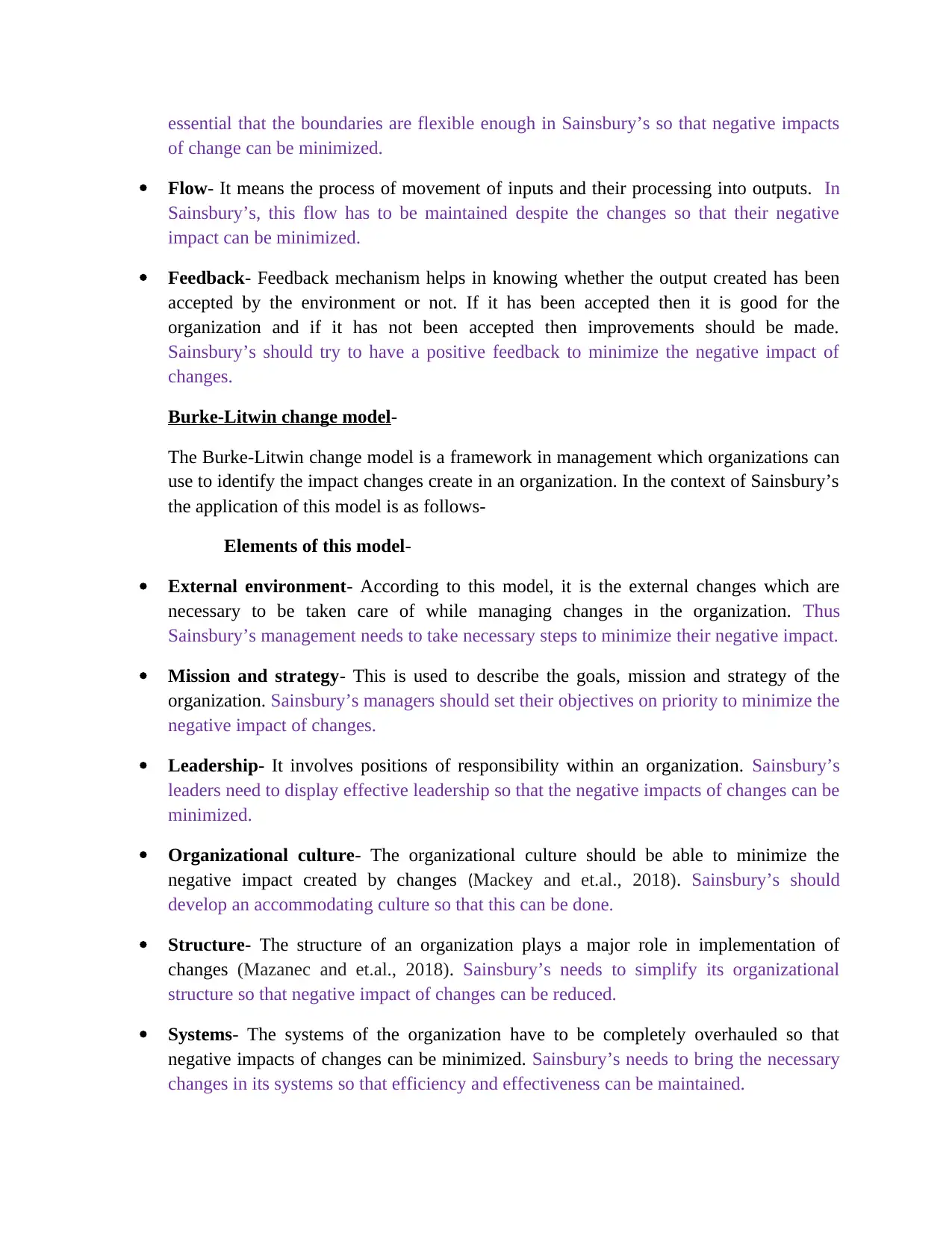
essential that the boundaries are flexible enough in Sainsbury’s so that negative impacts
of change can be minimized.
Flow- It means the process of movement of inputs and their processing into outputs. In
Sainsbury’s, this flow has to be maintained despite the changes so that their negative
impact can be minimized.
Feedback- Feedback mechanism helps in knowing whether the output created has been
accepted by the environment or not. If it has been accepted then it is good for the
organization and if it has not been accepted then improvements should be made.
Sainsbury’s should try to have a positive feedback to minimize the negative impact of
changes.
Burke-Litwin change model-
The Burke-Litwin change model is a framework in management which organizations can
use to identify the impact changes create in an organization. In the context of Sainsbury’s
the application of this model is as follows-
Elements of this model-
External environment- According to this model, it is the external changes which are
necessary to be taken care of while managing changes in the organization. Thus
Sainsbury’s management needs to take necessary steps to minimize their negative impact.
Mission and strategy- This is used to describe the goals, mission and strategy of the
organization. Sainsbury’s managers should set their objectives on priority to minimize the
negative impact of changes.
Leadership- It involves positions of responsibility within an organization. Sainsbury’s
leaders need to display effective leadership so that the negative impacts of changes can be
minimized.
Organizational culture- The organizational culture should be able to minimize the
negative impact created by changes (Mackey and et.al., 2018). Sainsbury’s should
develop an accommodating culture so that this can be done.
Structure- The structure of an organization plays a major role in implementation of
changes (Mazanec and et.al., 2018). Sainsbury’s needs to simplify its organizational
structure so that negative impact of changes can be reduced.
Systems- The systems of the organization have to be completely overhauled so that
negative impacts of changes can be minimized. Sainsbury’s needs to bring the necessary
changes in its systems so that efficiency and effectiveness can be maintained.
of change can be minimized.
Flow- It means the process of movement of inputs and their processing into outputs. In
Sainsbury’s, this flow has to be maintained despite the changes so that their negative
impact can be minimized.
Feedback- Feedback mechanism helps in knowing whether the output created has been
accepted by the environment or not. If it has been accepted then it is good for the
organization and if it has not been accepted then improvements should be made.
Sainsbury’s should try to have a positive feedback to minimize the negative impact of
changes.
Burke-Litwin change model-
The Burke-Litwin change model is a framework in management which organizations can
use to identify the impact changes create in an organization. In the context of Sainsbury’s
the application of this model is as follows-
Elements of this model-
External environment- According to this model, it is the external changes which are
necessary to be taken care of while managing changes in the organization. Thus
Sainsbury’s management needs to take necessary steps to minimize their negative impact.
Mission and strategy- This is used to describe the goals, mission and strategy of the
organization. Sainsbury’s managers should set their objectives on priority to minimize the
negative impact of changes.
Leadership- It involves positions of responsibility within an organization. Sainsbury’s
leaders need to display effective leadership so that the negative impacts of changes can be
minimized.
Organizational culture- The organizational culture should be able to minimize the
negative impact created by changes (Mackey and et.al., 2018). Sainsbury’s should
develop an accommodating culture so that this can be done.
Structure- The structure of an organization plays a major role in implementation of
changes (Mazanec and et.al., 2018). Sainsbury’s needs to simplify its organizational
structure so that negative impact of changes can be reduced.
Systems- The systems of the organization have to be completely overhauled so that
negative impacts of changes can be minimized. Sainsbury’s needs to bring the necessary
changes in its systems so that efficiency and effectiveness can be maintained.
Secure Best Marks with AI Grader
Need help grading? Try our AI Grader for instant feedback on your assignments.
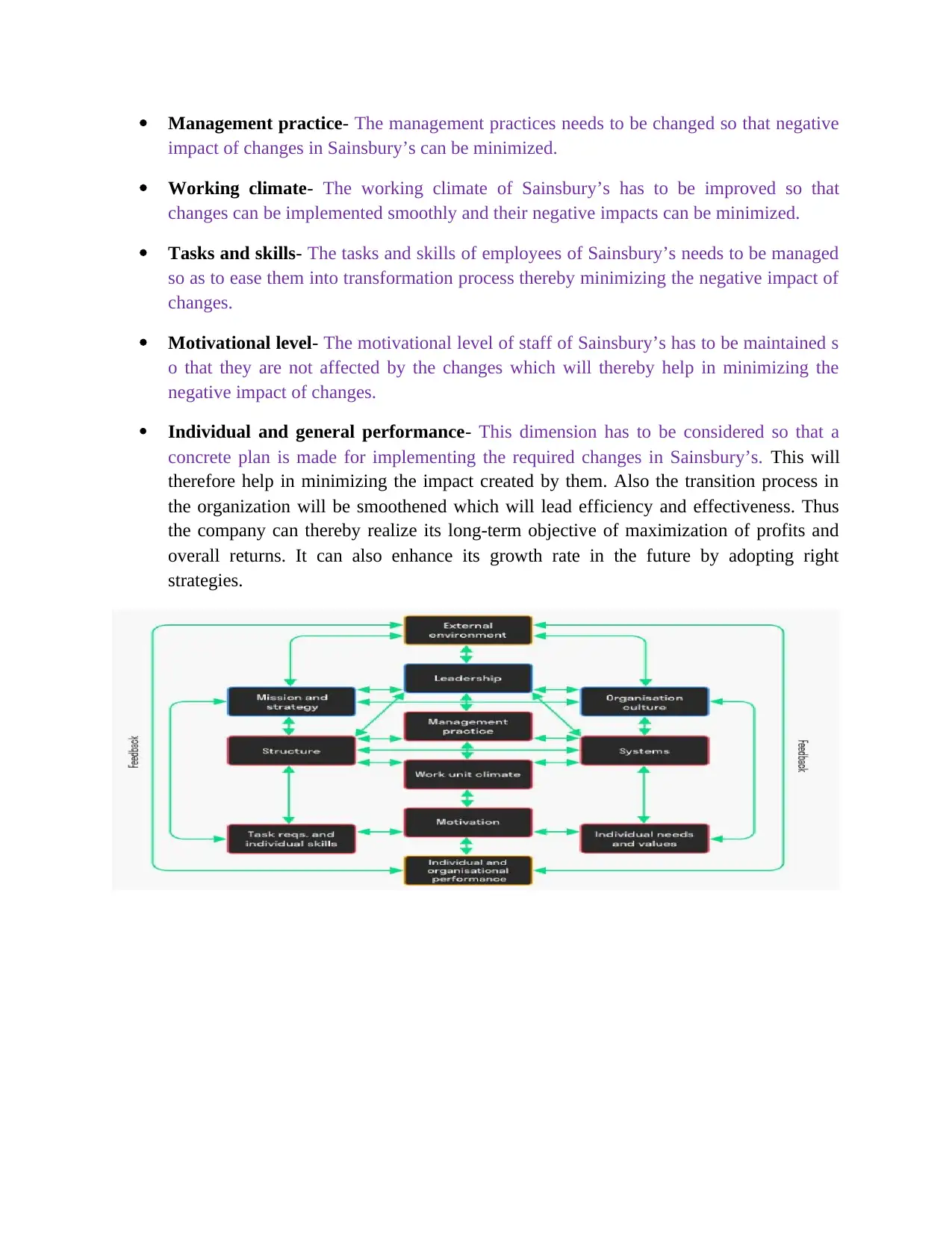
Management practice- The management practices needs to be changed so that negative
impact of changes in Sainsbury’s can be minimized.
Working climate- The working climate of Sainsbury’s has to be improved so that
changes can be implemented smoothly and their negative impacts can be minimized.
Tasks and skills- The tasks and skills of employees of Sainsbury’s needs to be managed
so as to ease them into transformation process thereby minimizing the negative impact of
changes.
Motivational level- The motivational level of staff of Sainsbury’s has to be maintained s
o that they are not affected by the changes which will thereby help in minimizing the
negative impact of changes.
Individual and general performance- This dimension has to be considered so that a
concrete plan is made for implementing the required changes in Sainsbury’s. This will
therefore help in minimizing the impact created by them. Also the transition process in
the organization will be smoothened which will lead efficiency and effectiveness. Thus
the company can thereby realize its long-term objective of maximization of profits and
overall returns. It can also enhance its growth rate in the future by adopting right
strategies.
impact of changes in Sainsbury’s can be minimized.
Working climate- The working climate of Sainsbury’s has to be improved so that
changes can be implemented smoothly and their negative impacts can be minimized.
Tasks and skills- The tasks and skills of employees of Sainsbury’s needs to be managed
so as to ease them into transformation process thereby minimizing the negative impact of
changes.
Motivational level- The motivational level of staff of Sainsbury’s has to be maintained s
o that they are not affected by the changes which will thereby help in minimizing the
negative impact of changes.
Individual and general performance- This dimension has to be considered so that a
concrete plan is made for implementing the required changes in Sainsbury’s. This will
therefore help in minimizing the impact created by them. Also the transition process in
the organization will be smoothened which will lead efficiency and effectiveness. Thus
the company can thereby realize its long-term objective of maximization of profits and
overall returns. It can also enhance its growth rate in the future by adopting right
strategies.
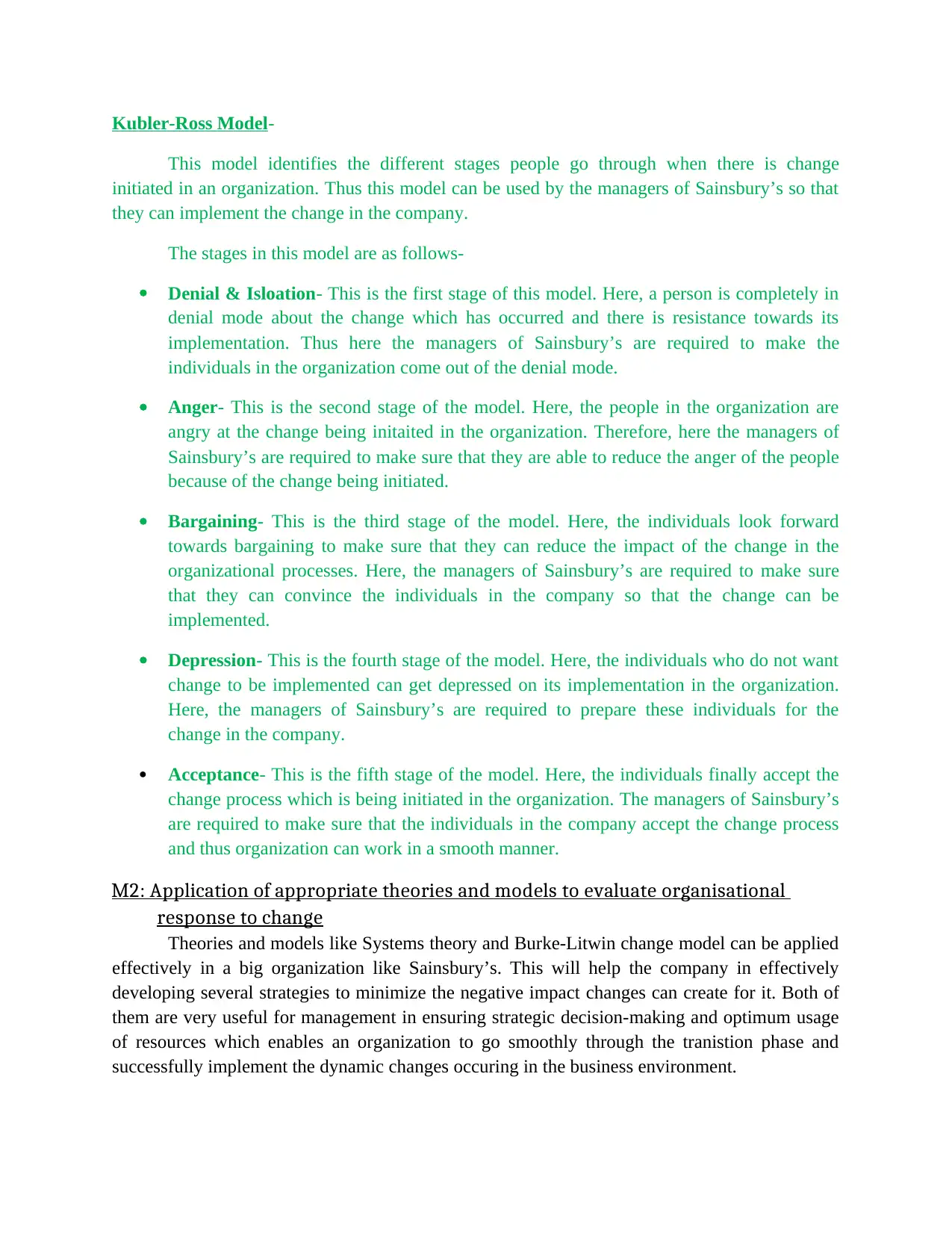
Kubler-Ross Model-
This model identifies the different stages people go through when there is change
initiated in an organization. Thus this model can be used by the managers of Sainsbury’s so that
they can implement the change in the company.
The stages in this model are as follows-
Denial & Isloation- This is the first stage of this model. Here, a person is completely in
denial mode about the change which has occurred and there is resistance towards its
implementation. Thus here the managers of Sainsbury’s are required to make the
individuals in the organization come out of the denial mode.
Anger- This is the second stage of the model. Here, the people in the organization are
angry at the change being initaited in the organization. Therefore, here the managers of
Sainsbury’s are required to make sure that they are able to reduce the anger of the people
because of the change being initiated.
Bargaining- This is the third stage of the model. Here, the individuals look forward
towards bargaining to make sure that they can reduce the impact of the change in the
organizational processes. Here, the managers of Sainsbury’s are required to make sure
that they can convince the individuals in the company so that the change can be
implemented.
Depression- This is the fourth stage of the model. Here, the individuals who do not want
change to be implemented can get depressed on its implementation in the organization.
Here, the managers of Sainsbury’s are required to prepare these individuals for the
change in the company.
Acceptance- This is the fifth stage of the model. Here, the individuals finally accept the
change process which is being initiated in the organization. The managers of Sainsbury’s
are required to make sure that the individuals in the company accept the change process
and thus organization can work in a smooth manner.
M2: Application of appropriate theories and models to evaluate organisational
response to change
Theories and models like Systems theory and Burke-Litwin change model can be applied
effectively in a big organization like Sainsbury’s. This will help the company in effectively
developing several strategies to minimize the negative impact changes can create for it. Both of
them are very useful for management in ensuring strategic decision-making and optimum usage
of resources which enables an organization to go smoothly through the tranistion phase and
successfully implement the dynamic changes occuring in the business environment.
This model identifies the different stages people go through when there is change
initiated in an organization. Thus this model can be used by the managers of Sainsbury’s so that
they can implement the change in the company.
The stages in this model are as follows-
Denial & Isloation- This is the first stage of this model. Here, a person is completely in
denial mode about the change which has occurred and there is resistance towards its
implementation. Thus here the managers of Sainsbury’s are required to make the
individuals in the organization come out of the denial mode.
Anger- This is the second stage of the model. Here, the people in the organization are
angry at the change being initaited in the organization. Therefore, here the managers of
Sainsbury’s are required to make sure that they are able to reduce the anger of the people
because of the change being initiated.
Bargaining- This is the third stage of the model. Here, the individuals look forward
towards bargaining to make sure that they can reduce the impact of the change in the
organizational processes. Here, the managers of Sainsbury’s are required to make sure
that they can convince the individuals in the company so that the change can be
implemented.
Depression- This is the fourth stage of the model. Here, the individuals who do not want
change to be implemented can get depressed on its implementation in the organization.
Here, the managers of Sainsbury’s are required to prepare these individuals for the
change in the company.
Acceptance- This is the fifth stage of the model. Here, the individuals finally accept the
change process which is being initiated in the organization. The managers of Sainsbury’s
are required to make sure that the individuals in the company accept the change process
and thus organization can work in a smooth manner.
M2: Application of appropriate theories and models to evaluate organisational
response to change
Theories and models like Systems theory and Burke-Litwin change model can be applied
effectively in a big organization like Sainsbury’s. This will help the company in effectively
developing several strategies to minimize the negative impact changes can create for it. Both of
them are very useful for management in ensuring strategic decision-making and optimum usage
of resources which enables an organization to go smoothly through the tranistion phase and
successfully implement the dynamic changes occuring in the business environment.
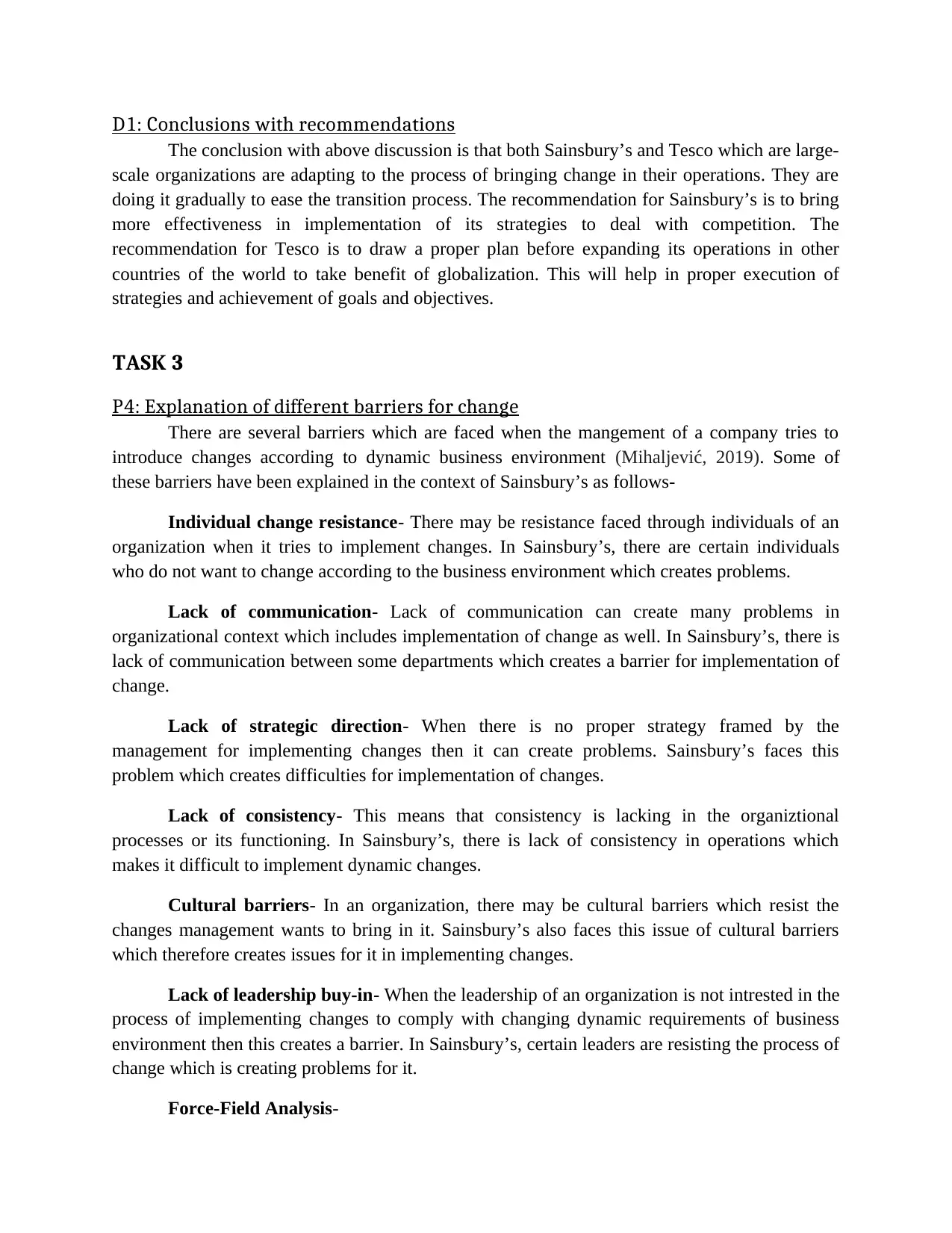
D1: Conclusions with recommendations
The conclusion with above discussion is that both Sainsbury’s and Tesco which are large-
scale organizations are adapting to the process of bringing change in their operations. They are
doing it gradually to ease the transition process. The recommendation for Sainsbury’s is to bring
more effectiveness in implementation of its strategies to deal with competition. The
recommendation for Tesco is to draw a proper plan before expanding its operations in other
countries of the world to take benefit of globalization. This will help in proper execution of
strategies and achievement of goals and objectives.
TASK 3
P4: Explanation of different barriers for change
There are several barriers which are faced when the mangement of a company tries to
introduce changes according to dynamic business environment (Mihaljević, 2019). Some of
these barriers have been explained in the context of Sainsbury’s as follows-
Individual change resistance- There may be resistance faced through individuals of an
organization when it tries to implement changes. In Sainsbury’s, there are certain individuals
who do not want to change according to the business environment which creates problems.
Lack of communication- Lack of communication can create many problems in
organizational context which includes implementation of change as well. In Sainsbury’s, there is
lack of communication between some departments which creates a barrier for implementation of
change.
Lack of strategic direction- When there is no proper strategy framed by the
management for implementing changes then it can create problems. Sainsbury’s faces this
problem which creates difficulties for implementation of changes.
Lack of consistency- This means that consistency is lacking in the organiztional
processes or its functioning. In Sainsbury’s, there is lack of consistency in operations which
makes it difficult to implement dynamic changes.
Cultural barriers- In an organization, there may be cultural barriers which resist the
changes management wants to bring in it. Sainsbury’s also faces this issue of cultural barriers
which therefore creates issues for it in implementing changes.
Lack of leadership buy-in- When the leadership of an organization is not intrested in the
process of implementing changes to comply with changing dynamic requirements of business
environment then this creates a barrier. In Sainsbury’s, certain leaders are resisting the process of
change which is creating problems for it.
Force-Field Analysis-
The conclusion with above discussion is that both Sainsbury’s and Tesco which are large-
scale organizations are adapting to the process of bringing change in their operations. They are
doing it gradually to ease the transition process. The recommendation for Sainsbury’s is to bring
more effectiveness in implementation of its strategies to deal with competition. The
recommendation for Tesco is to draw a proper plan before expanding its operations in other
countries of the world to take benefit of globalization. This will help in proper execution of
strategies and achievement of goals and objectives.
TASK 3
P4: Explanation of different barriers for change
There are several barriers which are faced when the mangement of a company tries to
introduce changes according to dynamic business environment (Mihaljević, 2019). Some of
these barriers have been explained in the context of Sainsbury’s as follows-
Individual change resistance- There may be resistance faced through individuals of an
organization when it tries to implement changes. In Sainsbury’s, there are certain individuals
who do not want to change according to the business environment which creates problems.
Lack of communication- Lack of communication can create many problems in
organizational context which includes implementation of change as well. In Sainsbury’s, there is
lack of communication between some departments which creates a barrier for implementation of
change.
Lack of strategic direction- When there is no proper strategy framed by the
management for implementing changes then it can create problems. Sainsbury’s faces this
problem which creates difficulties for implementation of changes.
Lack of consistency- This means that consistency is lacking in the organiztional
processes or its functioning. In Sainsbury’s, there is lack of consistency in operations which
makes it difficult to implement dynamic changes.
Cultural barriers- In an organization, there may be cultural barriers which resist the
changes management wants to bring in it. Sainsbury’s also faces this issue of cultural barriers
which therefore creates issues for it in implementing changes.
Lack of leadership buy-in- When the leadership of an organization is not intrested in the
process of implementing changes to comply with changing dynamic requirements of business
environment then this creates a barrier. In Sainsbury’s, certain leaders are resisting the process of
change which is creating problems for it.
Force-Field Analysis-
Paraphrase This Document
Need a fresh take? Get an instant paraphrase of this document with our AI Paraphraser
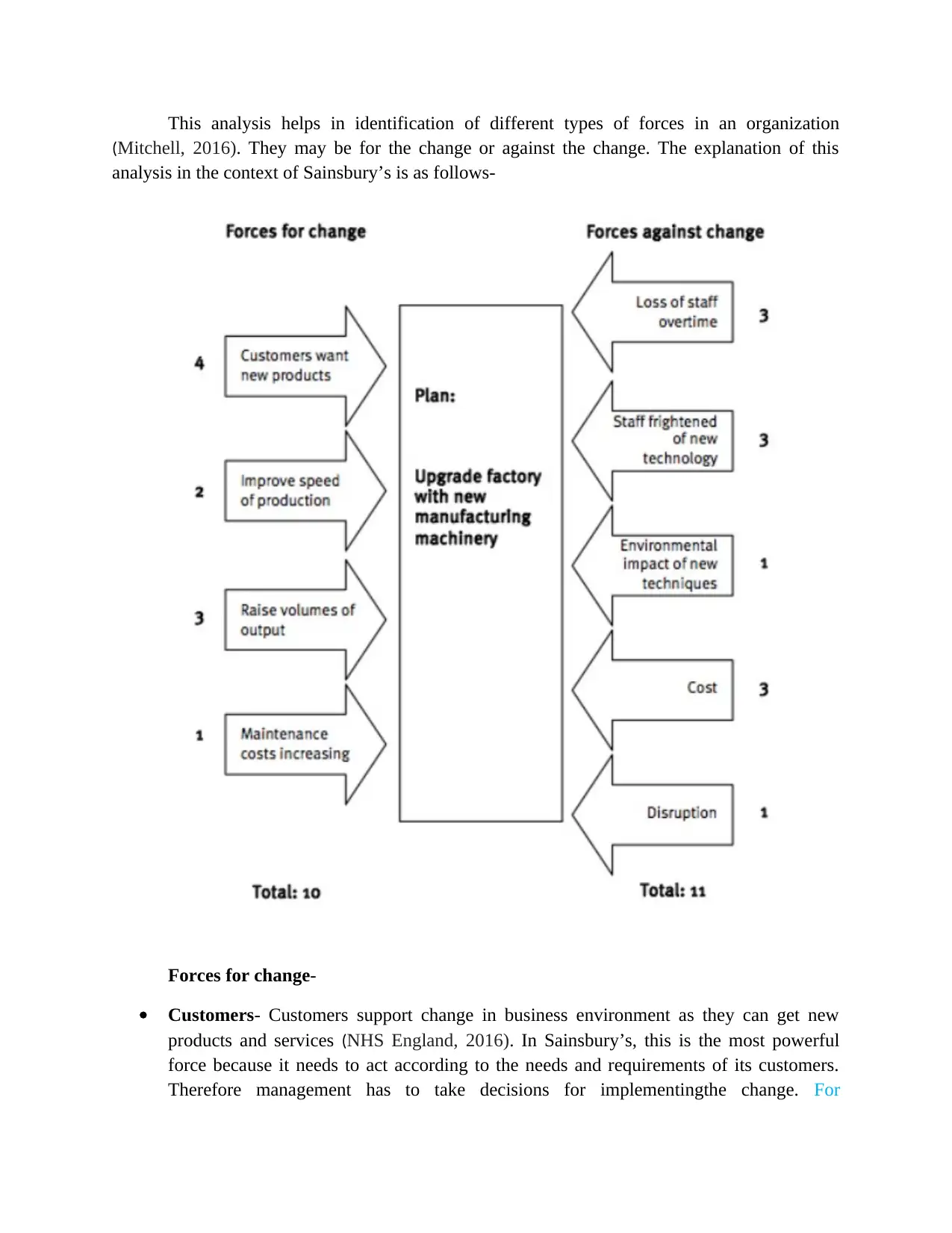
This analysis helps in identification of different types of forces in an organization
(Mitchell, 2016). They may be for the change or against the change. The explanation of this
analysis in the context of Sainsbury’s is as follows-
Forces for change-
Customers- Customers support change in business environment as they can get new
products and services (NHS England, 2016). In Sainsbury’s, this is the most powerful
force because it needs to act according to the needs and requirements of its customers.
Therefore management has to take decisions for implementingthe change. For
(Mitchell, 2016). They may be for the change or against the change. The explanation of this
analysis in the context of Sainsbury’s is as follows-
Forces for change-
Customers- Customers support change in business environment as they can get new
products and services (NHS England, 2016). In Sainsbury’s, this is the most powerful
force because it needs to act according to the needs and requirements of its customers.
Therefore management has to take decisions for implementingthe change. For
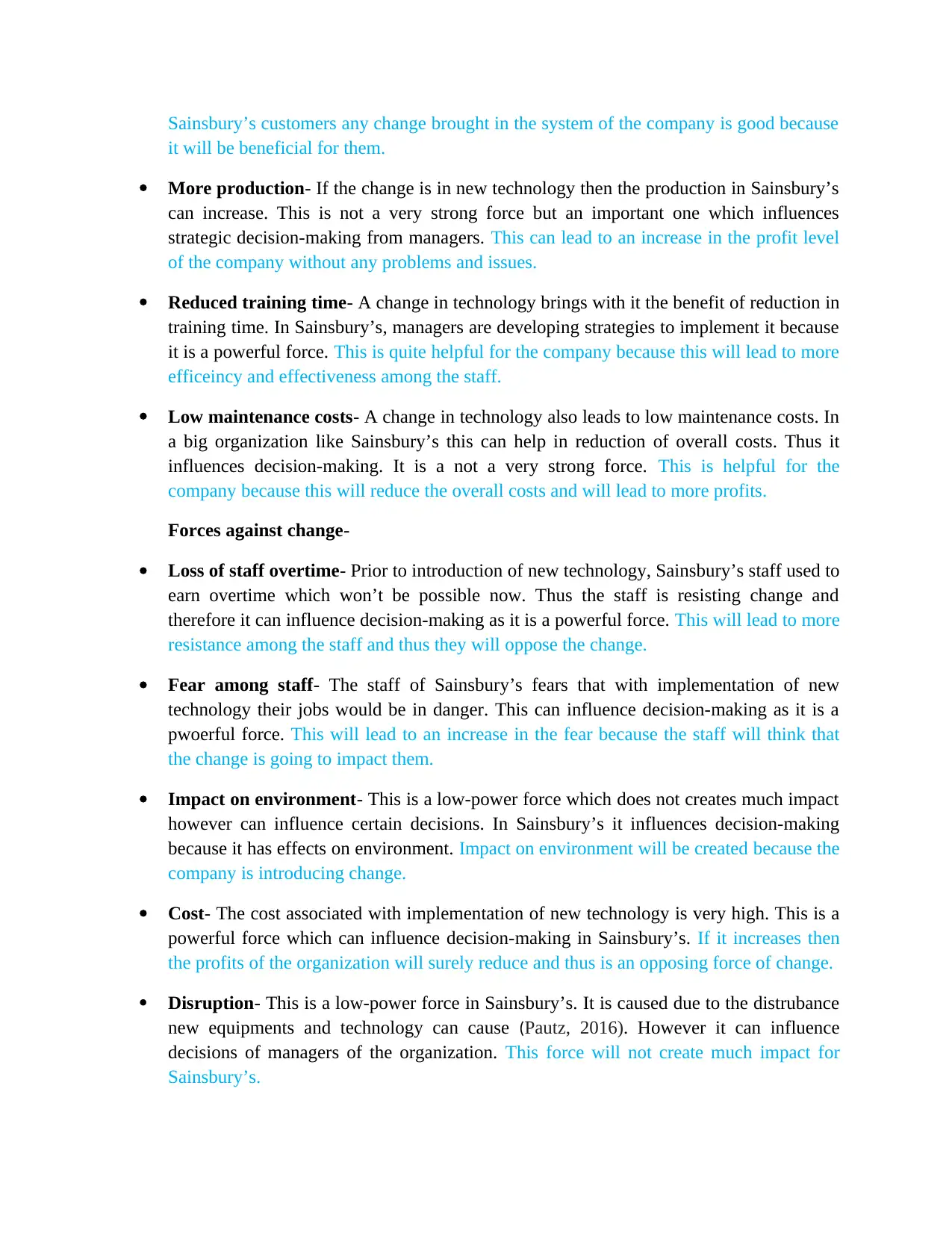
Sainsbury’s customers any change brought in the system of the company is good because
it will be beneficial for them.
More production- If the change is in new technology then the production in Sainsbury’s
can increase. This is not a very strong force but an important one which influences
strategic decision-making from managers. This can lead to an increase in the profit level
of the company without any problems and issues.
Reduced training time- A change in technology brings with it the benefit of reduction in
training time. In Sainsbury’s, managers are developing strategies to implement it because
it is a powerful force. This is quite helpful for the company because this will lead to more
efficeincy and effectiveness among the staff.
Low maintenance costs- A change in technology also leads to low maintenance costs. In
a big organization like Sainsbury’s this can help in reduction of overall costs. Thus it
influences decision-making. It is a not a very strong force. This is helpful for the
company because this will reduce the overall costs and will lead to more profits.
Forces against change-
Loss of staff overtime- Prior to introduction of new technology, Sainsbury’s staff used to
earn overtime which won’t be possible now. Thus the staff is resisting change and
therefore it can influence decision-making as it is a powerful force. This will lead to more
resistance among the staff and thus they will oppose the change.
Fear among staff- The staff of Sainsbury’s fears that with implementation of new
technology their jobs would be in danger. This can influence decision-making as it is a
pwoerful force. This will lead to an increase in the fear because the staff will think that
the change is going to impact them.
Impact on environment- This is a low-power force which does not creates much impact
however can influence certain decisions. In Sainsbury’s it influences decision-making
because it has effects on environment. Impact on environment will be created because the
company is introducing change.
Cost- The cost associated with implementation of new technology is very high. This is a
powerful force which can influence decision-making in Sainsbury’s. If it increases then
the profits of the organization will surely reduce and thus is an opposing force of change.
Disruption- This is a low-power force in Sainsbury’s. It is caused due to the distrubance
new equipments and technology can cause (Pautz, 2016). However it can influence
decisions of managers of the organization. This force will not create much impact for
Sainsbury’s.
it will be beneficial for them.
More production- If the change is in new technology then the production in Sainsbury’s
can increase. This is not a very strong force but an important one which influences
strategic decision-making from managers. This can lead to an increase in the profit level
of the company without any problems and issues.
Reduced training time- A change in technology brings with it the benefit of reduction in
training time. In Sainsbury’s, managers are developing strategies to implement it because
it is a powerful force. This is quite helpful for the company because this will lead to more
efficeincy and effectiveness among the staff.
Low maintenance costs- A change in technology also leads to low maintenance costs. In
a big organization like Sainsbury’s this can help in reduction of overall costs. Thus it
influences decision-making. It is a not a very strong force. This is helpful for the
company because this will reduce the overall costs and will lead to more profits.
Forces against change-
Loss of staff overtime- Prior to introduction of new technology, Sainsbury’s staff used to
earn overtime which won’t be possible now. Thus the staff is resisting change and
therefore it can influence decision-making as it is a powerful force. This will lead to more
resistance among the staff and thus they will oppose the change.
Fear among staff- The staff of Sainsbury’s fears that with implementation of new
technology their jobs would be in danger. This can influence decision-making as it is a
pwoerful force. This will lead to an increase in the fear because the staff will think that
the change is going to impact them.
Impact on environment- This is a low-power force which does not creates much impact
however can influence certain decisions. In Sainsbury’s it influences decision-making
because it has effects on environment. Impact on environment will be created because the
company is introducing change.
Cost- The cost associated with implementation of new technology is very high. This is a
powerful force which can influence decision-making in Sainsbury’s. If it increases then
the profits of the organization will surely reduce and thus is an opposing force of change.
Disruption- This is a low-power force in Sainsbury’s. It is caused due to the distrubance
new equipments and technology can cause (Pautz, 2016). However it can influence
decisions of managers of the organization. This force will not create much impact for
Sainsbury’s.
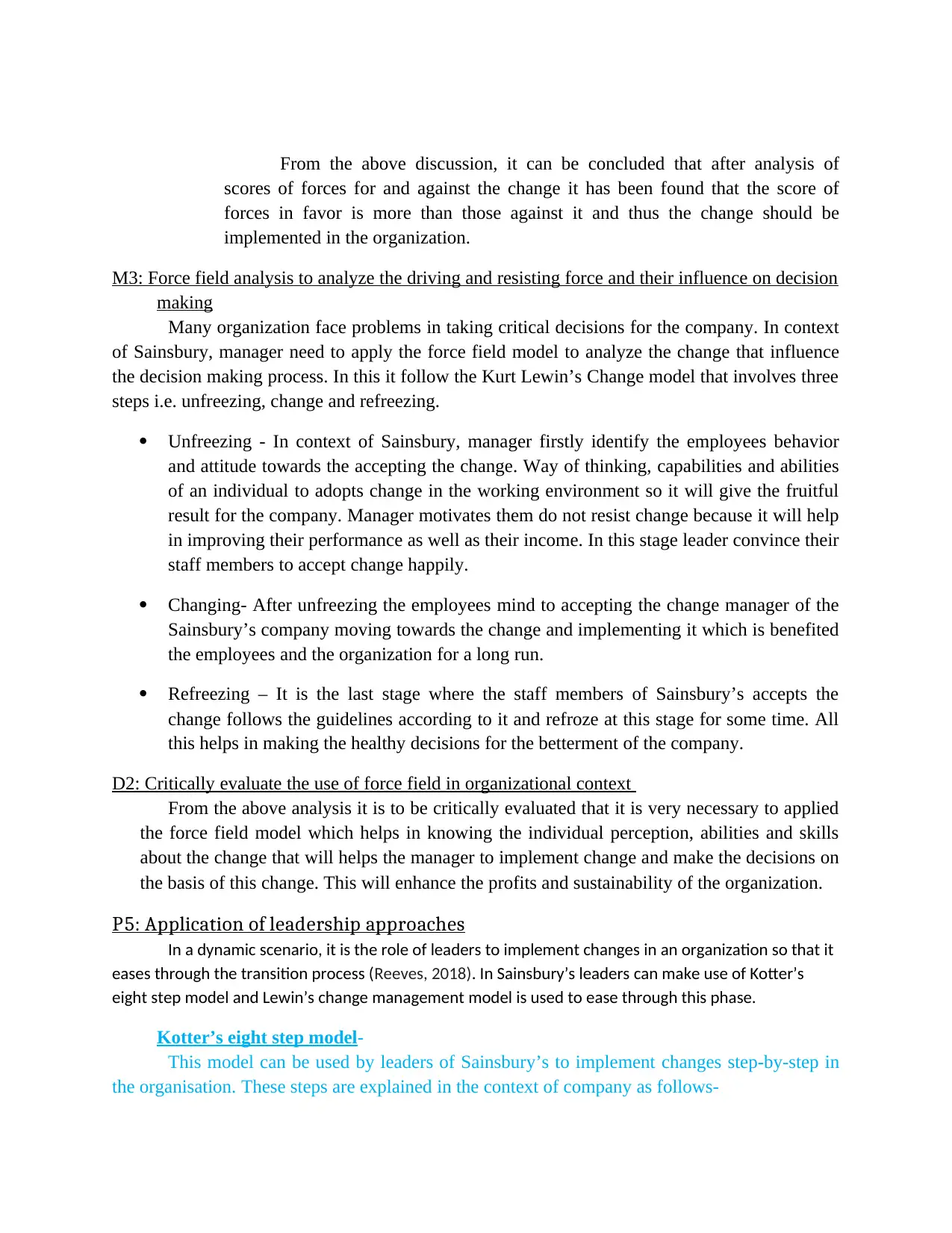
From the above discussion, it can be concluded that after analysis of
scores of forces for and against the change it has been found that the score of
forces in favor is more than those against it and thus the change should be
implemented in the organization.
M3: Force field analysis to analyze the driving and resisting force and their influence on decision
making
Many organization face problems in taking critical decisions for the company. In context
of Sainsbury, manager need to apply the force field model to analyze the change that influence
the decision making process. In this it follow the Kurt Lewin’s Change model that involves three
steps i.e. unfreezing, change and refreezing.
Unfreezing - In context of Sainsbury, manager firstly identify the employees behavior
and attitude towards the accepting the change. Way of thinking, capabilities and abilities
of an individual to adopts change in the working environment so it will give the fruitful
result for the company. Manager motivates them do not resist change because it will help
in improving their performance as well as their income. In this stage leader convince their
staff members to accept change happily.
Changing- After unfreezing the employees mind to accepting the change manager of the
Sainsbury’s company moving towards the change and implementing it which is benefited
the employees and the organization for a long run.
Refreezing – It is the last stage where the staff members of Sainsbury’s accepts the
change follows the guidelines according to it and refroze at this stage for some time. All
this helps in making the healthy decisions for the betterment of the company.
D2: Critically evaluate the use of force field in organizational context
From the above analysis it is to be critically evaluated that it is very necessary to applied
the force field model which helps in knowing the individual perception, abilities and skills
about the change that will helps the manager to implement change and make the decisions on
the basis of this change. This will enhance the profits and sustainability of the organization.
P5: Application of leadership approaches
In a dynamic scenario, it is the role of leaders to implement changes in an organization so that it
eases through the transition process (Reeves, 2018). In Sainsbury’s leaders can make use of Kotter’s
eight step model and Lewin’s change management model is used to ease through this phase.
Kotter’s eight step model-
This model can be used by leaders of Sainsbury’s to implement changes step-by-step in
the organisation. These steps are explained in the context of company as follows-
scores of forces for and against the change it has been found that the score of
forces in favor is more than those against it and thus the change should be
implemented in the organization.
M3: Force field analysis to analyze the driving and resisting force and their influence on decision
making
Many organization face problems in taking critical decisions for the company. In context
of Sainsbury, manager need to apply the force field model to analyze the change that influence
the decision making process. In this it follow the Kurt Lewin’s Change model that involves three
steps i.e. unfreezing, change and refreezing.
Unfreezing - In context of Sainsbury, manager firstly identify the employees behavior
and attitude towards the accepting the change. Way of thinking, capabilities and abilities
of an individual to adopts change in the working environment so it will give the fruitful
result for the company. Manager motivates them do not resist change because it will help
in improving their performance as well as their income. In this stage leader convince their
staff members to accept change happily.
Changing- After unfreezing the employees mind to accepting the change manager of the
Sainsbury’s company moving towards the change and implementing it which is benefited
the employees and the organization for a long run.
Refreezing – It is the last stage where the staff members of Sainsbury’s accepts the
change follows the guidelines according to it and refroze at this stage for some time. All
this helps in making the healthy decisions for the betterment of the company.
D2: Critically evaluate the use of force field in organizational context
From the above analysis it is to be critically evaluated that it is very necessary to applied
the force field model which helps in knowing the individual perception, abilities and skills
about the change that will helps the manager to implement change and make the decisions on
the basis of this change. This will enhance the profits and sustainability of the organization.
P5: Application of leadership approaches
In a dynamic scenario, it is the role of leaders to implement changes in an organization so that it
eases through the transition process (Reeves, 2018). In Sainsbury’s leaders can make use of Kotter’s
eight step model and Lewin’s change management model is used to ease through this phase.
Kotter’s eight step model-
This model can be used by leaders of Sainsbury’s to implement changes step-by-step in
the organisation. These steps are explained in the context of company as follows-
Secure Best Marks with AI Grader
Need help grading? Try our AI Grader for instant feedback on your assignments.
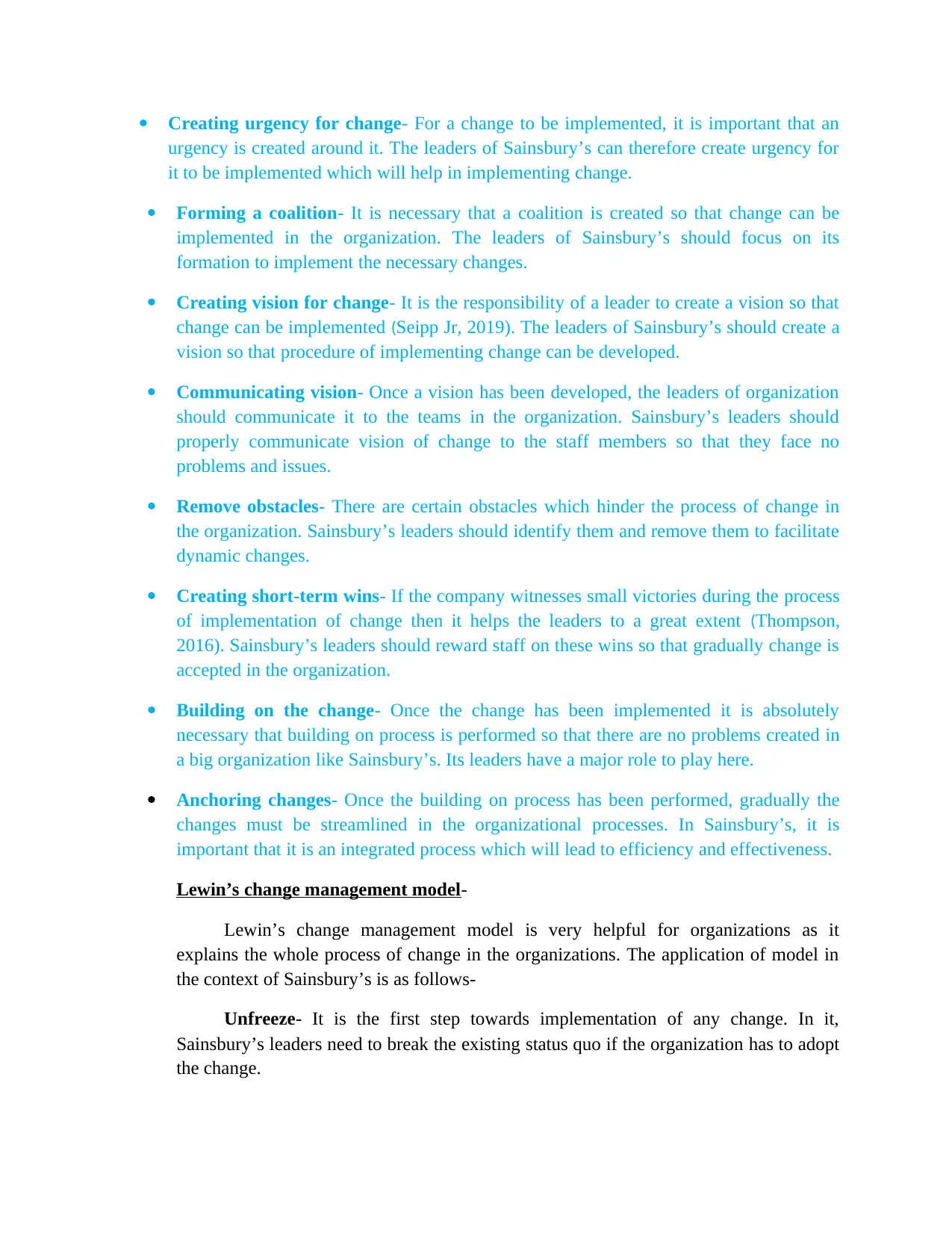
Creating urgency for change- For a change to be implemented, it is important that an
urgency is created around it. The leaders of Sainsbury’s can therefore create urgency for
it to be implemented which will help in implementing change.
Forming a coalition- It is necessary that a coalition is created so that change can be
implemented in the organization. The leaders of Sainsbury’s should focus on its
formation to implement the necessary changes.
Creating vision for change- It is the responsibility of a leader to create a vision so that
change can be implemented (Seipp Jr, 2019). The leaders of Sainsbury’s should create a
vision so that procedure of implementing change can be developed.
Communicating vision- Once a vision has been developed, the leaders of organization
should communicate it to the teams in the organization. Sainsbury’s leaders should
properly communicate vision of change to the staff members so that they face no
problems and issues.
Remove obstacles- There are certain obstacles which hinder the process of change in
the organization. Sainsbury’s leaders should identify them and remove them to facilitate
dynamic changes.
Creating short-term wins- If the company witnesses small victories during the process
of implementation of change then it helps the leaders to a great extent (Thompson,
2016). Sainsbury’s leaders should reward staff on these wins so that gradually change is
accepted in the organization.
Building on the change- Once the change has been implemented it is absolutely
necessary that building on process is performed so that there are no problems created in
a big organization like Sainsbury’s. Its leaders have a major role to play here.
Anchoring changes- Once the building on process has been performed, gradually the
changes must be streamlined in the organizational processes. In Sainsbury’s, it is
important that it is an integrated process which will lead to efficiency and effectiveness.
Lewin’s change management model-
Lewin’s change management model is very helpful for organizations as it
explains the whole process of change in the organizations. The application of model in
the context of Sainsbury’s is as follows-
Unfreeze- It is the first step towards implementation of any change. In it,
Sainsbury’s leaders need to break the existing status quo if the organization has to adopt
the change.
urgency is created around it. The leaders of Sainsbury’s can therefore create urgency for
it to be implemented which will help in implementing change.
Forming a coalition- It is necessary that a coalition is created so that change can be
implemented in the organization. The leaders of Sainsbury’s should focus on its
formation to implement the necessary changes.
Creating vision for change- It is the responsibility of a leader to create a vision so that
change can be implemented (Seipp Jr, 2019). The leaders of Sainsbury’s should create a
vision so that procedure of implementing change can be developed.
Communicating vision- Once a vision has been developed, the leaders of organization
should communicate it to the teams in the organization. Sainsbury’s leaders should
properly communicate vision of change to the staff members so that they face no
problems and issues.
Remove obstacles- There are certain obstacles which hinder the process of change in
the organization. Sainsbury’s leaders should identify them and remove them to facilitate
dynamic changes.
Creating short-term wins- If the company witnesses small victories during the process
of implementation of change then it helps the leaders to a great extent (Thompson,
2016). Sainsbury’s leaders should reward staff on these wins so that gradually change is
accepted in the organization.
Building on the change- Once the change has been implemented it is absolutely
necessary that building on process is performed so that there are no problems created in
a big organization like Sainsbury’s. Its leaders have a major role to play here.
Anchoring changes- Once the building on process has been performed, gradually the
changes must be streamlined in the organizational processes. In Sainsbury’s, it is
important that it is an integrated process which will lead to efficiency and effectiveness.
Lewin’s change management model-
Lewin’s change management model is very helpful for organizations as it
explains the whole process of change in the organizations. The application of model in
the context of Sainsbury’s is as follows-
Unfreeze- It is the first step towards implementation of any change. In it,
Sainsbury’s leaders need to break the existing status quo if the organization has to adopt
the change.
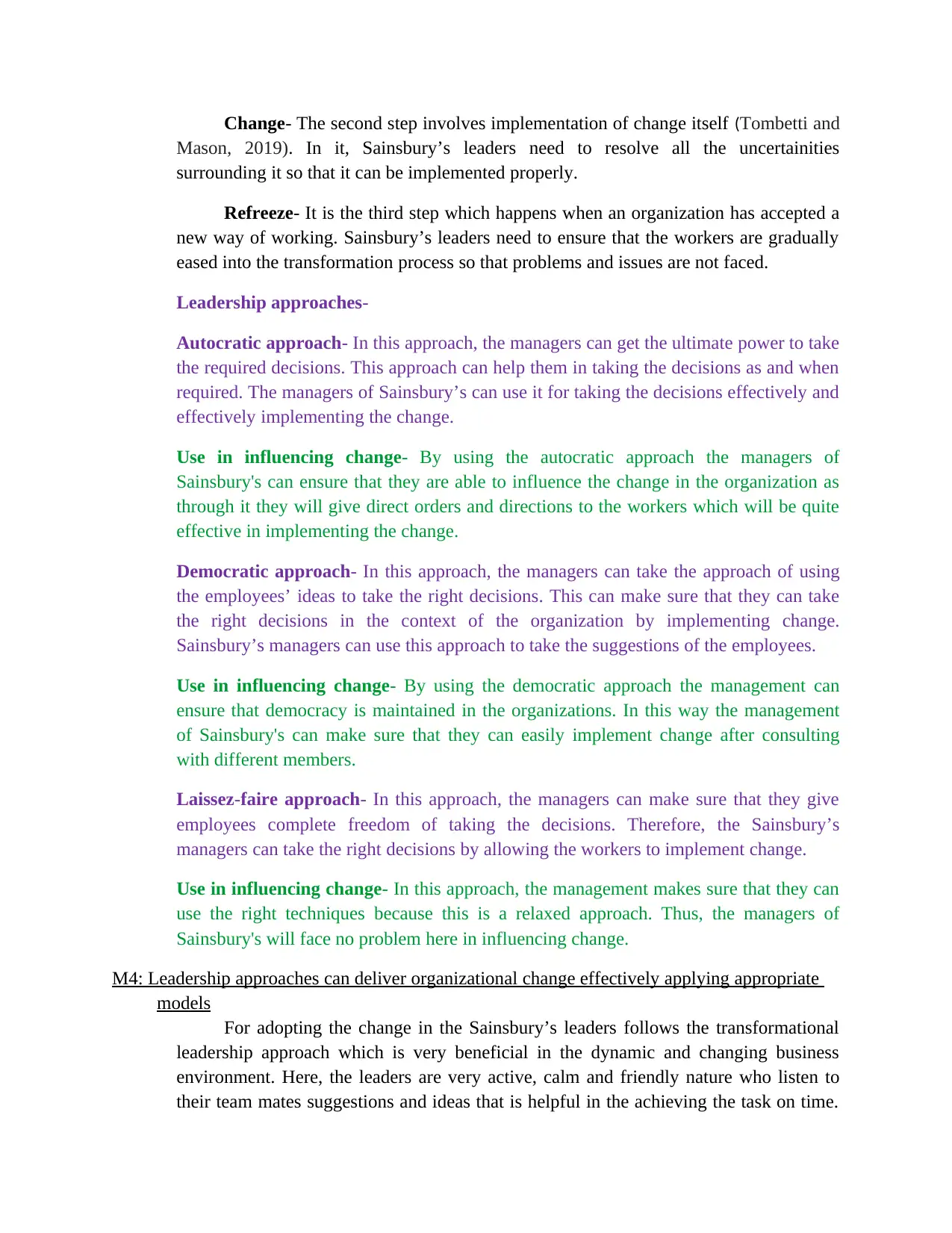
Change- The second step involves implementation of change itself (Tombetti and
Mason, 2019). In it, Sainsbury’s leaders need to resolve all the uncertainities
surrounding it so that it can be implemented properly.
Refreeze- It is the third step which happens when an organization has accepted a
new way of working. Sainsbury’s leaders need to ensure that the workers are gradually
eased into the transformation process so that problems and issues are not faced.
Leadership approaches-
Autocratic approach- In this approach, the managers can get the ultimate power to take
the required decisions. This approach can help them in taking the decisions as and when
required. The managers of Sainsbury’s can use it for taking the decisions effectively and
effectively implementing the change.
Use in influencing change- By using the autocratic approach the managers of
Sainsbury's can ensure that they are able to influence the change in the organization as
through it they will give direct orders and directions to the workers which will be quite
effective in implementing the change.
Democratic approach- In this approach, the managers can take the approach of using
the employees’ ideas to take the right decisions. This can make sure that they can take
the right decisions in the context of the organization by implementing change.
Sainsbury’s managers can use this approach to take the suggestions of the employees.
Use in influencing change- By using the democratic approach the management can
ensure that democracy is maintained in the organizations. In this way the management
of Sainsbury's can make sure that they can easily implement change after consulting
with different members.
Laissez-faire approach- In this approach, the managers can make sure that they give
employees complete freedom of taking the decisions. Therefore, the Sainsbury’s
managers can take the right decisions by allowing the workers to implement change.
Use in influencing change- In this approach, the management makes sure that they can
use the right techniques because this is a relaxed approach. Thus, the managers of
Sainsbury's will face no problem here in influencing change.
M4: Leadership approaches can deliver organizational change effectively applying appropriate
models
For adopting the change in the Sainsbury’s leaders follows the transformational
leadership approach which is very beneficial in the dynamic and changing business
environment. Here, the leaders are very active, calm and friendly nature who listen to
their team mates suggestions and ideas that is helpful in the achieving the task on time.
Mason, 2019). In it, Sainsbury’s leaders need to resolve all the uncertainities
surrounding it so that it can be implemented properly.
Refreeze- It is the third step which happens when an organization has accepted a
new way of working. Sainsbury’s leaders need to ensure that the workers are gradually
eased into the transformation process so that problems and issues are not faced.
Leadership approaches-
Autocratic approach- In this approach, the managers can get the ultimate power to take
the required decisions. This approach can help them in taking the decisions as and when
required. The managers of Sainsbury’s can use it for taking the decisions effectively and
effectively implementing the change.
Use in influencing change- By using the autocratic approach the managers of
Sainsbury's can ensure that they are able to influence the change in the organization as
through it they will give direct orders and directions to the workers which will be quite
effective in implementing the change.
Democratic approach- In this approach, the managers can take the approach of using
the employees’ ideas to take the right decisions. This can make sure that they can take
the right decisions in the context of the organization by implementing change.
Sainsbury’s managers can use this approach to take the suggestions of the employees.
Use in influencing change- By using the democratic approach the management can
ensure that democracy is maintained in the organizations. In this way the management
of Sainsbury's can make sure that they can easily implement change after consulting
with different members.
Laissez-faire approach- In this approach, the managers can make sure that they give
employees complete freedom of taking the decisions. Therefore, the Sainsbury’s
managers can take the right decisions by allowing the workers to implement change.
Use in influencing change- In this approach, the management makes sure that they can
use the right techniques because this is a relaxed approach. Thus, the managers of
Sainsbury's will face no problem here in influencing change.
M4: Leadership approaches can deliver organizational change effectively applying appropriate
models
For adopting the change in the Sainsbury’s leaders follows the transformational
leadership approach which is very beneficial in the dynamic and changing business
environment. Here, the leaders are very active, calm and friendly nature who listen to
their team mates suggestions and ideas that is helpful in the achieving the task on time.
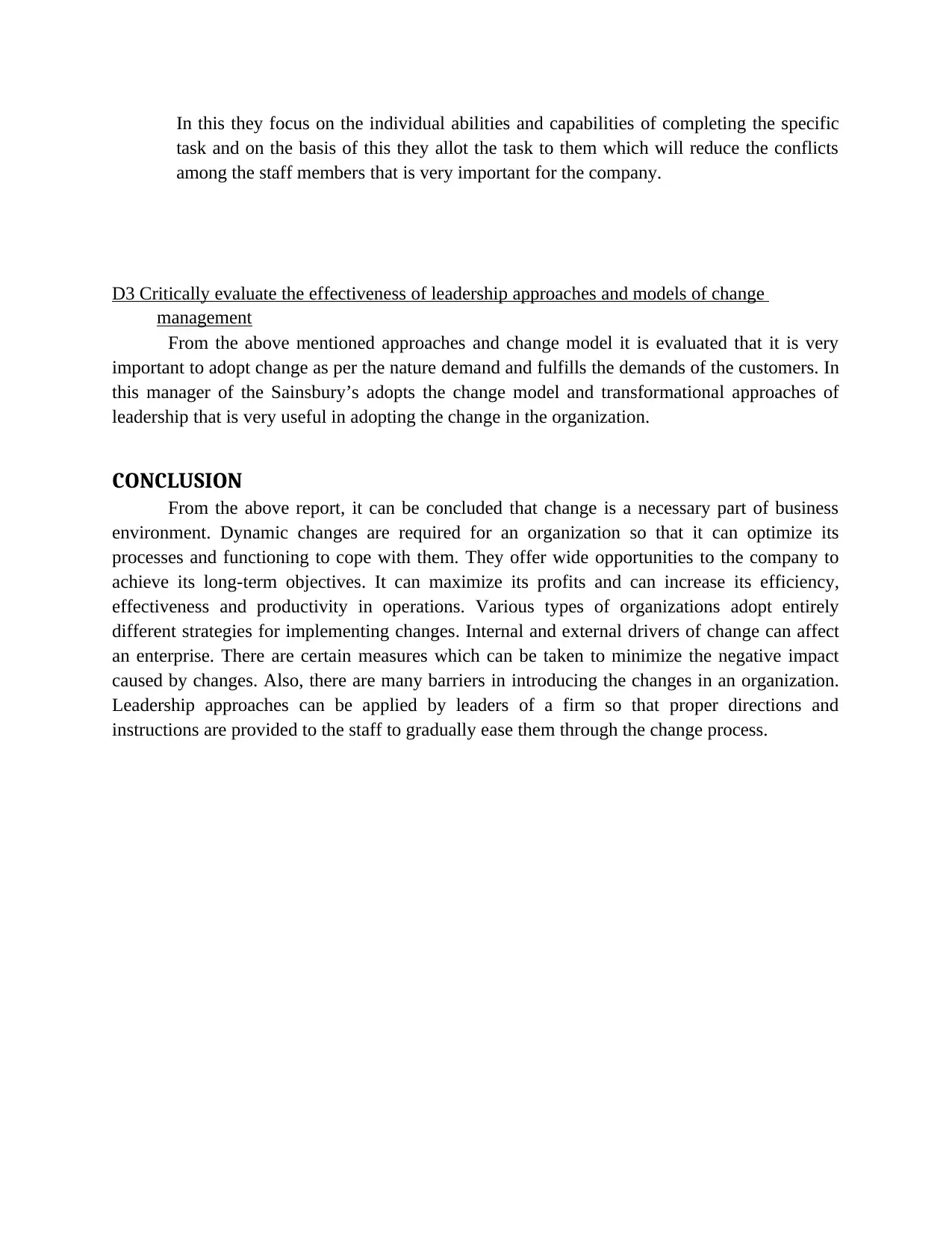
In this they focus on the individual abilities and capabilities of completing the specific
task and on the basis of this they allot the task to them which will reduce the conflicts
among the staff members that is very important for the company.
D3 Critically evaluate the effectiveness of leadership approaches and models of change
management
From the above mentioned approaches and change model it is evaluated that it is very
important to adopt change as per the nature demand and fulfills the demands of the customers. In
this manager of the Sainsbury’s adopts the change model and transformational approaches of
leadership that is very useful in adopting the change in the organization.
CONCLUSION
From the above report, it can be concluded that change is a necessary part of business
environment. Dynamic changes are required for an organization so that it can optimize its
processes and functioning to cope with them. They offer wide opportunities to the company to
achieve its long-term objectives. It can maximize its profits and can increase its efficiency,
effectiveness and productivity in operations. Various types of organizations adopt entirely
different strategies for implementing changes. Internal and external drivers of change can affect
an enterprise. There are certain measures which can be taken to minimize the negative impact
caused by changes. Also, there are many barriers in introducing the changes in an organization.
Leadership approaches can be applied by leaders of a firm so that proper directions and
instructions are provided to the staff to gradually ease them through the change process.
task and on the basis of this they allot the task to them which will reduce the conflicts
among the staff members that is very important for the company.
D3 Critically evaluate the effectiveness of leadership approaches and models of change
management
From the above mentioned approaches and change model it is evaluated that it is very
important to adopt change as per the nature demand and fulfills the demands of the customers. In
this manager of the Sainsbury’s adopts the change model and transformational approaches of
leadership that is very useful in adopting the change in the organization.
CONCLUSION
From the above report, it can be concluded that change is a necessary part of business
environment. Dynamic changes are required for an organization so that it can optimize its
processes and functioning to cope with them. They offer wide opportunities to the company to
achieve its long-term objectives. It can maximize its profits and can increase its efficiency,
effectiveness and productivity in operations. Various types of organizations adopt entirely
different strategies for implementing changes. Internal and external drivers of change can affect
an enterprise. There are certain measures which can be taken to minimize the negative impact
caused by changes. Also, there are many barriers in introducing the changes in an organization.
Leadership approaches can be applied by leaders of a firm so that proper directions and
instructions are provided to the staff to gradually ease them through the change process.
Paraphrase This Document
Need a fresh take? Get an instant paraphrase of this document with our AI Paraphraser
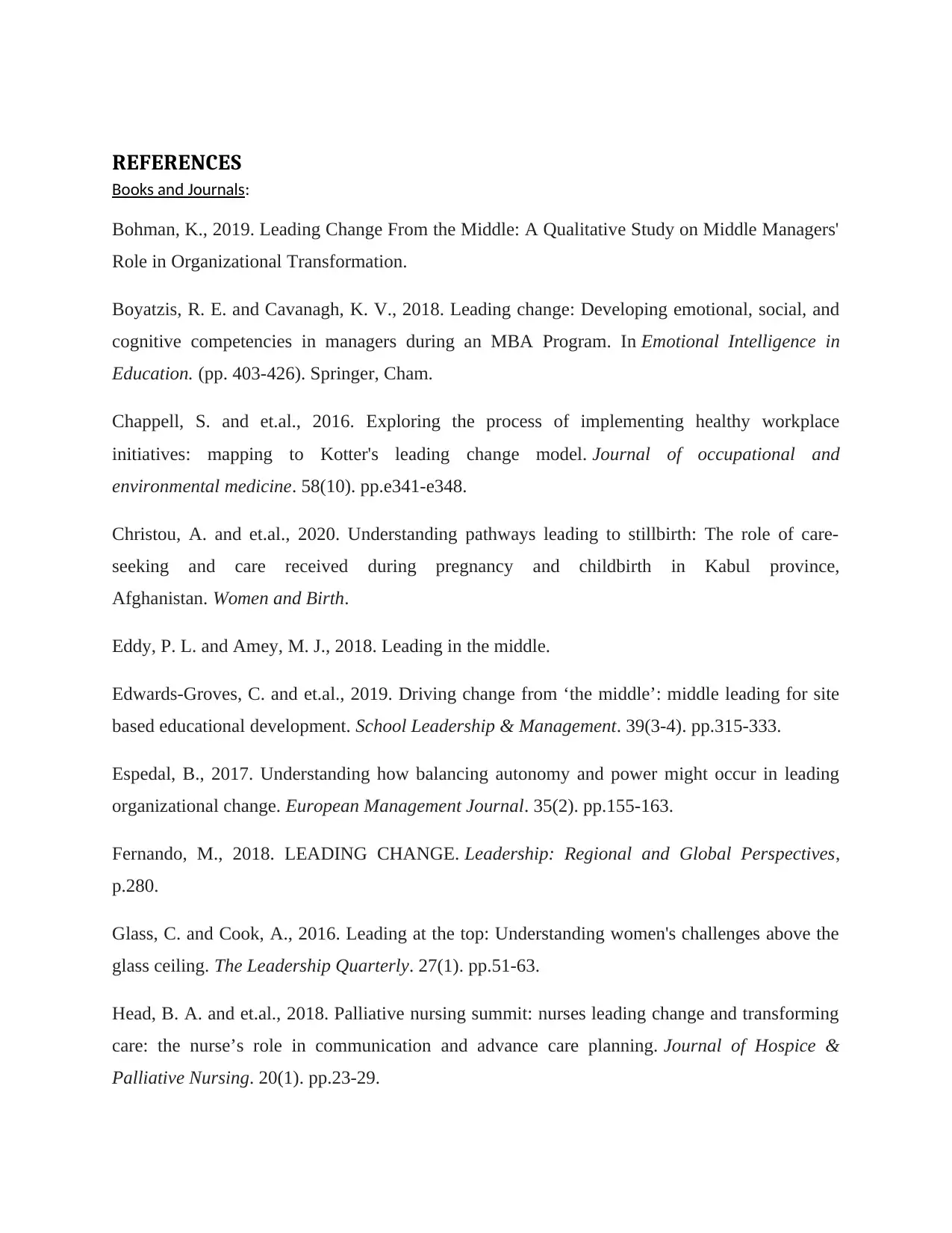
REFERENCES
Books and Journals:
Bohman, K., 2019. Leading Change From the Middle: A Qualitative Study on Middle Managers'
Role in Organizational Transformation.
Boyatzis, R. E. and Cavanagh, K. V., 2018. Leading change: Developing emotional, social, and
cognitive competencies in managers during an MBA Program. In Emotional Intelligence in
Education. (pp. 403-426). Springer, Cham.
Chappell, S. and et.al., 2016. Exploring the process of implementing healthy workplace
initiatives: mapping to Kotter's leading change model. Journal of occupational and
environmental medicine. 58(10). pp.e341-e348.
Christou, A. and et.al., 2020. Understanding pathways leading to stillbirth: The role of care-
seeking and care received during pregnancy and childbirth in Kabul province,
Afghanistan. Women and Birth.
Eddy, P. L. and Amey, M. J., 2018. Leading in the middle.
Edwards-Groves, C. and et.al., 2019. Driving change from ‘the middle’: middle leading for site
based educational development. School Leadership & Management. 39(3-4). pp.315-333.
Espedal, B., 2017. Understanding how balancing autonomy and power might occur in leading
organizational change. European Management Journal. 35(2). pp.155-163.
Fernando, M., 2018. LEADING CHANGE. Leadership: Regional and Global Perspectives,
p.280.
Glass, C. and Cook, A., 2016. Leading at the top: Understanding women's challenges above the
glass ceiling. The Leadership Quarterly. 27(1). pp.51-63.
Head, B. A. and et.al., 2018. Palliative nursing summit: nurses leading change and transforming
care: the nurse’s role in communication and advance care planning. Journal of Hospice &
Palliative Nursing. 20(1). pp.23-29.
Books and Journals:
Bohman, K., 2019. Leading Change From the Middle: A Qualitative Study on Middle Managers'
Role in Organizational Transformation.
Boyatzis, R. E. and Cavanagh, K. V., 2018. Leading change: Developing emotional, social, and
cognitive competencies in managers during an MBA Program. In Emotional Intelligence in
Education. (pp. 403-426). Springer, Cham.
Chappell, S. and et.al., 2016. Exploring the process of implementing healthy workplace
initiatives: mapping to Kotter's leading change model. Journal of occupational and
environmental medicine. 58(10). pp.e341-e348.
Christou, A. and et.al., 2020. Understanding pathways leading to stillbirth: The role of care-
seeking and care received during pregnancy and childbirth in Kabul province,
Afghanistan. Women and Birth.
Eddy, P. L. and Amey, M. J., 2018. Leading in the middle.
Edwards-Groves, C. and et.al., 2019. Driving change from ‘the middle’: middle leading for site
based educational development. School Leadership & Management. 39(3-4). pp.315-333.
Espedal, B., 2017. Understanding how balancing autonomy and power might occur in leading
organizational change. European Management Journal. 35(2). pp.155-163.
Fernando, M., 2018. LEADING CHANGE. Leadership: Regional and Global Perspectives,
p.280.
Glass, C. and Cook, A., 2016. Leading at the top: Understanding women's challenges above the
glass ceiling. The Leadership Quarterly. 27(1). pp.51-63.
Head, B. A. and et.al., 2018. Palliative nursing summit: nurses leading change and transforming
care: the nurse’s role in communication and advance care planning. Journal of Hospice &
Palliative Nursing. 20(1). pp.23-29.

Heinz, M. and Fleming, M., 2019. Leading change in teacher education: Balancing on the
wobbly bridge of school-university partnership. European Journal of Educational Research.
Leibovich, A. K., Hildreth, M. and Columbus, L., 2017. Leading Change in Undergraduate
STEM Education. In Educational and Outreach Projects from the Cottrell Scholars
Collaborative Undergraduate and Graduate Education Volume 1 (pp. 1-13). American Chemical
Society.
Mackey, J. and et.al., 2018. Leading change to co-teaching in primary schools: a “Down Under”
experience. Educational Review. 70(4). pp.465-485.
Mazanec, P. and et.al., 2018. Palliative Nursing Summit: Nurses Leading Change and
Transforming Care The Nurse’s Role in Coordination of Care and Transition
Management. Journal of Hospice & Palliative Nursing. 20(1). pp.15-22.
Mihaljević, S., 2019. Managing and Leading Change in Higher Education Institutions: The
Example of Doctoral Education (Doctoral dissertation, University of Zagreb. Faculty of
Organization and Informatics.).
Mitchell, E. T., 2016. Leading change in cultural heritage institutions. Technical Services
Quarterly, 33(1), pp.42-51.
NHS England, 2016. Leading Change, Adding Value: NHS England's commitments and case
studies. British Journal of Healthcare Assistants. 10(11). pp.562-567.
Pautz, S. N., 2016. Leading change: a phenomenological analysis of principals’ experience in a
1: 1 computing initiative.
Reeves, D., 2018. LEADING CHANGE: Moving on from the Ninth World Urban
Forum. Planning Quarterly. (209).
Seipp Jr, D., 2019. Leading Change: Examining the Relationships between Leadership Style,
Organizational Culture and Change Readiness in Christian Universities of the State of Oregon.
Thompson, C. J., 2016. Disruptive innovation in graduate nursing education: leading
change. Clinical Nurse Specialist. 30(3). pp.177-179.
wobbly bridge of school-university partnership. European Journal of Educational Research.
Leibovich, A. K., Hildreth, M. and Columbus, L., 2017. Leading Change in Undergraduate
STEM Education. In Educational and Outreach Projects from the Cottrell Scholars
Collaborative Undergraduate and Graduate Education Volume 1 (pp. 1-13). American Chemical
Society.
Mackey, J. and et.al., 2018. Leading change to co-teaching in primary schools: a “Down Under”
experience. Educational Review. 70(4). pp.465-485.
Mazanec, P. and et.al., 2018. Palliative Nursing Summit: Nurses Leading Change and
Transforming Care The Nurse’s Role in Coordination of Care and Transition
Management. Journal of Hospice & Palliative Nursing. 20(1). pp.15-22.
Mihaljević, S., 2019. Managing and Leading Change in Higher Education Institutions: The
Example of Doctoral Education (Doctoral dissertation, University of Zagreb. Faculty of
Organization and Informatics.).
Mitchell, E. T., 2016. Leading change in cultural heritage institutions. Technical Services
Quarterly, 33(1), pp.42-51.
NHS England, 2016. Leading Change, Adding Value: NHS England's commitments and case
studies. British Journal of Healthcare Assistants. 10(11). pp.562-567.
Pautz, S. N., 2016. Leading change: a phenomenological analysis of principals’ experience in a
1: 1 computing initiative.
Reeves, D., 2018. LEADING CHANGE: Moving on from the Ninth World Urban
Forum. Planning Quarterly. (209).
Seipp Jr, D., 2019. Leading Change: Examining the Relationships between Leadership Style,
Organizational Culture and Change Readiness in Christian Universities of the State of Oregon.
Thompson, C. J., 2016. Disruptive innovation in graduate nursing education: leading
change. Clinical Nurse Specialist. 30(3). pp.177-179.

Tombetti, E. and Mason, J. C., 2019. Takayasu arteritis: advanced understanding is leading to
new horizons. Rheumatology. 58(2). pp.206-219.
Online
Systems theory. 2018. [Online]. Available through:<https://smallbusiness.chron.com/application-
systems-theory-business-organizations-73405.html>
new horizons. Rheumatology. 58(2). pp.206-219.
Online
Systems theory. 2018. [Online]. Available through:<https://smallbusiness.chron.com/application-
systems-theory-business-organizations-73405.html>
1 out of 22
Related Documents
Your All-in-One AI-Powered Toolkit for Academic Success.
+13062052269
info@desklib.com
Available 24*7 on WhatsApp / Email
![[object Object]](/_next/static/media/star-bottom.7253800d.svg)
Unlock your academic potential
© 2024 | Zucol Services PVT LTD | All rights reserved.





